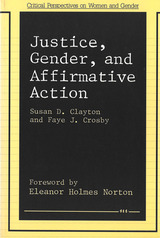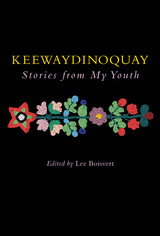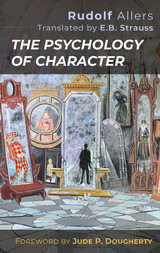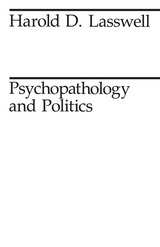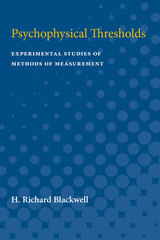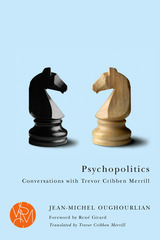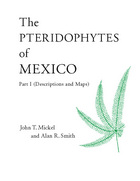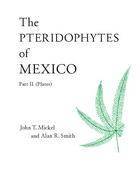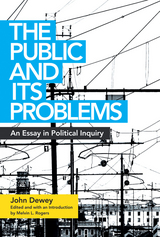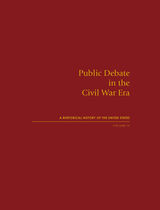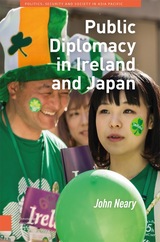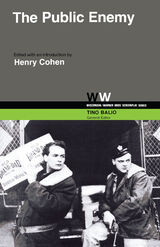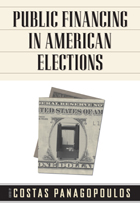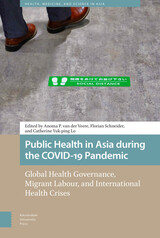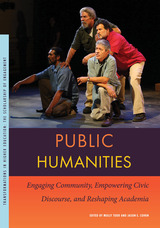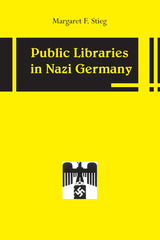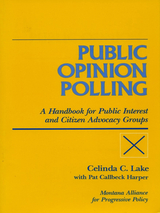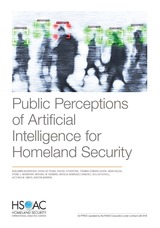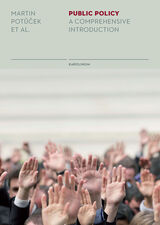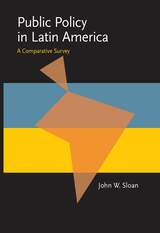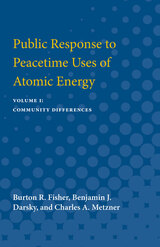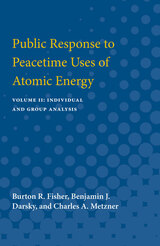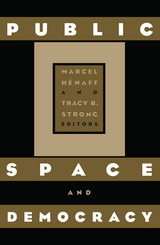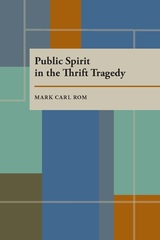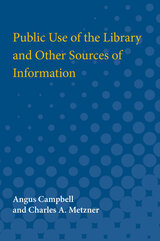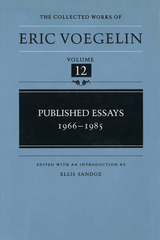The Psychological Mystique
Stewart Justman
Northwestern University Press, 1998 The Psychological Mystique weighs the extraordinary influence of psychology on culture, traces the therapeutic model to its roots, and examines the connection between psychology and the marketing of goods and ideas. Justman finds that psychology's influence has saturated contemporary life both public and private. Thoughtful and at times sardonic, this study links psychology both to the mass production of goods and the propagation of clichés.
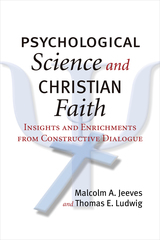 Psychological Science and Christian Faith: Insights and Enrichments from Constructive Dialogue
Malcolm A. Jeeves
Templeton Press, 2018 Is it possible to integrate scientific psychology with a Christian understanding of human nature? Are science and religion locked in an inevitable conflict, or is there an underlying harmony between these two sources of knowledge about humans? This book goes to the heart of the past and present dialogue between Christianity and psychology, comparing three models that have been used to describe the relationship between them.
Because Christianity and psychology deal with different levels of truth and speak vastly different languages, efforts to unify them often create more problems than they solve. What is needed is a better way to think about the relationship—an approach that does justice to the emerging insights from psychological science and biblical scholarship and that can enrich our understanding of both. In this volume, two accomplished psychologists show how this complementary dialogue can unfold, giving us a broader, deeper understanding of ourselves, our relationships, and our place in the cosmos.
.
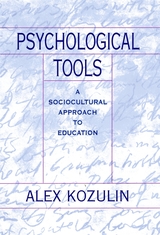 Psychological Tools: A Sociocultural Approach to Education
Alex Kozulin
Harvard University Press, 1998 The concept of "psychological tools" is a cornerstone of L. S. Vygotsky's sociocultural theory of cognitive development. Psychological tools are the symbolic cultural artifacts--signs, symbols, texts, formulae, and most fundamentally, language--that enable us to master psychological functions like memory, perception, and attention in ways appropriate to our cultures. In this lucid book, Alex Kozulin argues that the concept offers a useful way to analyze cross-cultural differences in thought and to develop practical strategies for educating immigrant children from widely different cultures.
Kozulin begins by offering an overview of Vygotsky's theory, which argues that consciousness arises from communication as civilization transforms "natural" psychological functions into "cultural" ones. He also compares sociocultural theory to other innovative approaches to learning, cognitive education in particular. And in a vivid case study, the author describes his work with recent Ethiopian immigrants to Israel, whose traditional modes of learning were oral and imitative, and who consequently proved to be quick at learning conversational Hebrew, but who struggled with the reading, writing, and formal problem solving required by a Western classroom. Last, Kozulin develops Vygotsky's concept of psychological tools to promote literature as a useful tool in cognitive development.
With its explication of Vygotsky's theory, its case study of sociocultural pedagogy, and its suggested use of literary text for cognitive development, Psychological Tools will be of considerable interest to research psychologists and educators alike.
The Psychological World of Natsume Soseki
Takeo Doi
Harvard University Press, 1976 This book offers an analysis of ten works by the leading twentieth-century Japanese novelist Natsume Soseki (1867–1916), by one of Japan's most distinguished psychiatrists. Dr. Takeo Doi, whose Amae no Kozo is well known in the West in its English translation, The Anatomy of Dependency, describes the principal characters of Soseki's novels from a psychological point of view, treating them as case studies and demonstrating the clarity and accuracy of Soseki's psychological insights.
This volume, one of the few pieces of literary criticism ever translated from the Japanese, will introduce the reader to these novels, some of which are not available in English. Furthermore, the book is a penetrating account of the universal problems faced by individuals coping with a rapidly modernizing society.
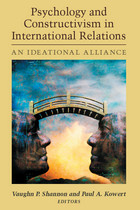 Psychology and Constructivism in International Relations: An Ideational Alliance
Vaughn P. Shannon and Paul A. Kowert, Editors
University of Michigan Press, 2011 "The conversation between political psychology and constructivism is essential and long overdue. By exploring the interaction of individual cognition and social processes, this 'ideational alliance' more fully explains how ideas work all the way down to shape world politics."
---Theo Farrell, King's College London "This is a worthwhile and engaging volume. Political psychology is gaining ground as an essential perspective to consider when analyzing international relations, and the book's focus on constructivism provides key insights into the relationship between identity, norms, and behavior---bedrock concepts in understanding the social underpinnings of global politics."
---Mira Sucharov, Carleton University "An indispensable guide to understanding what distinguishes and what unites psychology and constructivism. A wonderful resource for political psychologists, constructivists, and their critics."
---Jonathan Mercer, University of Washington Constructivist IR scholars study the ways in which international norms, culture, and identities---all intersubjective phenomena---inform foreign policy and affect the reaction to and outcomes of international events. Political psychologists similarly investigate divergent national self-conceptions as well as the individual cognitive and emotional propensities that shape ideology and policy. Given their mutual interest in human subjectivity and identity politics, a dialogue and synthesis between constructivism and political psychology is long overdue. The contributors to this volume discuss both theoretical and empirical issues of complementarity and critique, with an emphasis on the potential for integrating the viewpoints within a progressive ideational paradigm. Moreover, they make a self-conscious effort to interrogate, rather than gloss over, their differences in the hope that such disagreements will prove particularly rich sources of analytical and empirical insight. Jacket illustration © Ocean Photography/Veer
 Psychology and Politics: Intersections of Science and Ideology in the History of Psy-Sciences
Ferenc Eros
Central European University Press, 2019 Psy-sciences (psychology, psychiatry, psychoanalysis, pedagogy, criminology, special education, etc.) have been connected to politics in different ways since the early twentieth century. Here in twenty-two essays scholars address a variety of these intersections from a historical perspective.
The chapters include such diverse topics as the cultural history of psychoanalysis, the complicated relationship between psychoanalysis and the occult, and the struggles for dominance between the various schools of psychology. They show the ambivalent positions of the "psy" sciences in the dictatorships and authoritarian regimes of Nazi Germany, East European communism, Latin-American military dictatorships, and South African apartheid, revealing the crucial role of psychology in legitimating and "normalizing" these regimes.
The authors also discuss the ideological and political aspects of mental health and illness in Hungary, Germany, post-WW1 Transylvania, and Russia. Other chapters describe the attempt by critical psychology to understand the production of academic, therapeutic, and everyday psychological knowledge in the context of the power relations of modern capitalist societies.
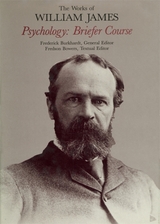 Psychology: Briefer Course
William James
Harvard University Press, 1984 Today's scholars know James's psychology primarily through his great Principles of Psychology (1890), but those who studied the subject at the turn of the century were more apt to learn his view through his Psychology: Briefer Course (1892). Indeed, professors at colleges and universities throughout the United States use this book--which their students labeled "Jimmy" to distinguish it from the larger "James"--in their classes, and more than six times as many copies of the Briefer Course were sold by 1902 as were sets of Principles.
Despite its title, the Briefer Course is more than a simple condensation of the larger work. For example, to the material from Principles James added several chapters on the physiology of the senses that helped mesh his psychology with the other sciences of the period. The earlier chapter title "The Stream of Thought" is replaced here with "The Stream of Consciousness." Psychology: Briefer Course remains a useful and highly readable introduction to James's views on psychology and is an essential source for anyone interested in studying all of his psychological writings.
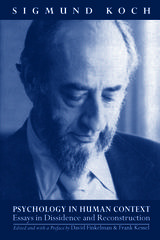 Psychology in Human Context: Essays in Dissidence and Reconstruction
Sigmund Koch
University of Chicago Press, 1999 Sigmund Koch (1917-1996) was one of the twentieth century's most penetrating and wide-ranging critics of the scientistic ambitions of psychology. Writing in a style sometimes scathing, sometimes witty, always lucid, he decried any psychology that attempted to eradicate the human dimension from the study, scientific and otherwise, of human experience and action. A philosopher and humanist by nature, Koch also sought to change the multifaceted field of psychology by moving it closer to the humanities and arts.
The broad scope of essays in Psychology in Human Context—which began as the basis for the eagerly anticipated postscript to Koch's seminal Psychology: A Study of a Science—reveals his writings to be as fresh and relevant today as ever. Carefully edited by two of Koch's close associates, this collection places psychological and philosophical issues in the context of twentieth-century thought and provides intellectual and moral signposts for future travelers in what Koch regarded as the irreducibly rich and human realm of the psychological studies.
Sigmund Koch was University Professor of Psychology and Philosophy at Boston University, the editor of the landmark six-volume series Psychology: A Study of a Science (1959-1963) and coeditor of A Century of Psychology as Science. He served as the president of three divisions of the American Psychological Association and was director of the Ford Foundation program in the Humanities and the Arts (1964-1967).
The Psychology of Character
Rudolf Allers
Catholic University of America Press, 2022 "How we became what we are. There are many explanations. One plausible account is found in the work of Rudolph Allers who writes about the European intellectual landscape from 1850 to the opening decades of the twentieth century...Allers is not alone in recognizing that a true account of human nature may await the recovery of classical antiquity. From Plato and Aristotle, modernity may learn that the immaterial or spiritual component of human nature is not empirically discerned but reasoned to from empirical evidence." - from the foreword by Jude Dougherty
 The Psychology of Childbirth
Aidan Macfarlane
Harvard University Press, 1977 The physical process of birth is no longer as mysterious as it once was. But many unanswered psychological questions still surround the birth of a child. In this remarkably appealing and personable book, pediatrician Aidan Macfarlane takes a careful look at a large number of these important psychological unknowns.
On Macfarlane's agenda: Can a woman's emotional attitude toward pregnancy cause “morning sickness,” influence the smoothness of labor and delivery, or shape the child's behavior after birth? Can the mother-child relationship be adversely affected by separation immediately after birth? Is the quality of the birth experience improved by home delivery? What are the psychological effects of pain-killing drugs on mother and child? What, if anything, does the unborn infant see, hear, and feel inside the womb? Is birth a psychological trauma for the child and, if so, how can it be alleviated?
Although Dr. Macfarlane refuses to provide easy answers to any of these questions, his clear discussion of the available evidence is not without important consequences for the way in which we understand birth and manage it in our society.
 Psychology of Reasoning: Structure and Content
P. Wason
Harvard University Press, 1972 "'Is there any other point to which you would wish to draw my attention?' 'To the curious incident of the dog in the night-time.' 'The dog did nothing in the night-time.' 'That was the curious incident,' remarked Sherlock Holmes." The quotation from A. Conan Doyle with which this book begins, is a delightfully appropriate summation of the authors' point of view garnered from their fifteen years of experiments on the psychology of reasoning.
Dr. Wason and Dr. Johnson-Laird are intrigued by the extent to which most individuals can be considered naturally rational thinkers. They present here the surprising results of their comprehensive investigations of how humans draw explicit conclusions from evidence. "Given a set of assertions," the authors write, "to what extent can the individual appreciate all that follows from them by virtue of logic alone, and remain unseduced by plausible, but fallacious conclusions? We are not concerned with whether these assertions are true or false, nor with whether the individual holds them among his beliefs, nor with whether they are sane or silly."
At the core of the Psychology of Reasoning is a vigorous discussion that incorporates various illustrations--some of them humorous, all of them fascinating--of the use of reason under a wide variety of different conditions. Particular emphasis is placed on the difficulties involved in dealing with negatively marked information that must be combined and used with other information for reaching conclusions. Thorough treatment is given as well to the search for plausible contexts that will render anomalous or ambiguous statements "sensible."
The authors have strived to isolate the components of inference, the basic steps of any kind of deductive activity, in order to determine the psychological processes involved in them. What has been the outcome of this research? Dr. Wason and Dr. Johnson-Laird conclude, "our research has suggested that the individual's logical competence may be either enhanced or limited by performance variables. And, of these, content has turned out to be vitally important for revealing, or obscuring structure. At best, we can all think like logicians; at worst, logicians all think like us."
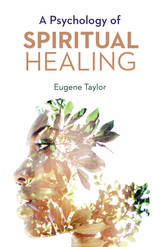 A Psychology of Spiritual Healing
EUGENE TAYLOR
Swedenborg Foundation Publishers, 1997 In this comprehensive work, Eugene Taylor uses the tenets of modern psychology, concepts from the world's religions, and a lifetime of spiritual experiences and interior exploration to show how true healing comes from within. Taylor asserts that "consciousness and healing are linked and this connection can best be understood within the context of a growth-oriented psychology of self-realization." Everyone has the capacity to develop a healing personality.
Drawing from such diverse interpreters of transcendental and psychological experiences as William James, Emanuel Swedenborg, Mircea Eliade, Carl Jung, Victor Frankl, and Abraham Maslow, Taylor explores the divisions between science and religious traditions; presents his own personal experiences, including his meetings with the Dalai Lama and Tenzin Norgay; and provides glimpses into the spiritual lives of others who have shared their experiences with him. The function of belief in the alleviation of suffering, the development of self-awareness, and the importance of human relationships form the basis for Taylor's psychology of spiritual healing. This cogent work both provides answers and raises questions for the spiritual seeker.
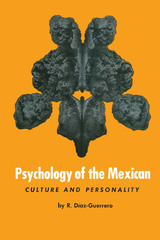 Psychology of the Mexican: Culture and Personality
By R. Díaz-Guerrero
University of Texas Press, 1975 In his quest to understand and describe the behavior of the Mexican, the distinguished Mexican psychologist R. Díaz-Guerrero combines a strong theoretical interest in the relationship of culture to personality with a pragmatic concern for methodology. This collection of essays is rooted both in studies of Mexican psychology as an independent phenomenon and in cross-cultural comparisons of Mexicans, Mexican-Americans, and Anglo-Americans. Dr. Díaz-Guerrero discusses Mexican attitudes toward sex roles and the family, motivations of the Mexican worker, and other topics. He compares Mexican and American concepts of respect and analyzes the relation between neurosis and the Mexican family structure. He attempts to determine the degree of mental, personal, and social health of urban Mexicans. The importance of basic sociocultural premises, such as "The mother is the dearest person in existence," and "The stricter the parents are, the better the children turn out," is explored. In one essay, Díaz-Guerrero notes the differences in typical reactions to stress in Mexico and the United States, concluding that the American pattern involves active response to stress, whereas the Mexican response tends to be more passive. Psychology of the Mexican deals with a variety of historical, psychological, biological, social, economic, and anthropological variables, attempting to treat them in a scientific way through the use of carefully constructed questionnaires, with detailed statistical analyses of the results. On the basis of data obtained in this way, the author formulates broad conceptual schemes with immediate application to the understanding of human behavior in real situations. He is particularly intrigued by the way the individual relates to the significant people in his environment. For the Mexican, he says, such interpersonal relationships are the most important part of life; in contrast to the American insistence on liberty and equality, Mexican culture emphasizes affiliation and love.
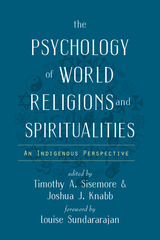 The Psychology of World Religions and Spiritualities: An Indigenous Perspective
Timothy A. Sisemore
Templeton Press, 2020 This compendium of introductory essays invites scholars and clinicians to better understand people of various faiths from around the world. It is intended to correct the tendency among scientists to study religious behavior without accounting for its human dimension. For example: a psychologist describes a religious ceremony in a certain community as a "sociological phenomenon." Such a technical description is likely to strike members of that community as an attempt by science to explain away their beliefs. This is counterproductive. In order to work effectively and empathetically with people of faith, psychologists should seek an intimate knowledge of how religion operates in the hearts and minds of living, breathing human beings.
With this goal in mind, editors Timothy Sisemore and Joshua Knabb have made one of the world’s major religions the subject of a separate chapter. In addition, they have arranged for each chapter to be written by a psychologist who practices—or is culturally connected with—that religion. This marks the book’s unique contribution to the field: it is the product of people who have lived the world’s religions, not merely studied them. By taking such a respectful approach, the book promotes an appreciation for the ways that religious belief animates, inspires, and instructs its adherents. Moreover, the indigenous point-of-view of these essays will help scholars identify their own biases when researching religious groups, allowing them to produce more accurate and holistic analyses.
Psychologists understand that religion and spirituality provide meaning and purpose to billions of people around the globe. But the actual experience of these beliefs eludes the grasp of the reductionistic methods of science. With this resource at their side, psychologists in academic and clinical settings will be equipped to understand religious experience from the bottom-up, and honor the beliefs and practices of the people they are trying to help.
Psychology: The Briefer Course
William James
University of Notre Dame Press, 1985
“William James is a towering figure in the history of American thought--without doubt the foremost psychologist this country has produced. His depiction of mental life is faithful, vital, and subtle. In verve, he has no equal. . . . “There is a sharp contrast between the expanding horizon of James and the constricting horizon of much contemporary psychology. The one opens doors to discovery, the other closes them. Much psychology today is written in terms of reaction, little in terms of becoming. James would say that a balance is needed, but that only by assuming that man has the capacity for growth are we likely to discover the scope of this same capacity.” —from the introduction by Gordon W. Allport
 Psycho-Marxism: Marxism and Psychoanalysis Late in the Twentieth Century, Volume 97
Robert Miklitsch, spec issue ed
Duke University Press This special issue of South Atlantic Quarterly examines the recent theoretical convergence of psychoanalysis and Marxism by posing anew the question of the relationship between these two master discourses in the era of late capitalism. Beginning with Zizek’s “Psychoanalysis in Post-Marxism,” which both dramatizes and analyzes the discursive antinomies of psycho-Marxism, this volume comes full circle with Robert Miklitsch’s “Going through the Fantasy,” which seeks the “traumatic kernel” at the core of Zizekian theory. In other essays, psycho-Marxism is submitted to Foucault’s analytics of power/knowledge, Derrida’s spectral letter, the postcolonial theory of Homi Bhabha and Gayatri Spivak, and the performative politics/poetics of Jean Genet. The theoretical perspectives of Laura Mulvey and Gayle Rubin are crosscut and spliced to take women out of commodity traffic and put feminist automobility up on the big screen. Imperialism, Nazi psychoanalytic techno-fetishism, and the strange alliance between (anti)queer Marxism and gay conservatism provide other useful lenses through which the Marxist/psychoanalytic bond is viewed. Contributors. Elizabeth Jane Bellamy, Teresa Brennan, Rosaria Champagne, Stathis Gourgouris, Catherine Liu, Kathleen McHugh, Robert Miklitsch, Abdul-Karim Mustapha, Laurence A. Rickels, Eugene Victor Wolfenstein, Slavoj Zizek
Psychometrics: A Study of Psychological Measurements
Johnson O'Connor
Harvard University Press Some say that the theory of special abilities died a hundred years ago; others that it is the only sound approach to a better understanding of the human mind. This book describes experiments which have led to the discovery of seven elements of the mind and to the partial isolation of two others. It is written primarily for the scientist who is interested in an approach to psychology which may do for that subject what the discovery of the elements did for chemistry. In addition, it is of interest to the general reader as the first groping steps in a new science and as a description of the experiments on which is based the work of the Human Engineering Laboratories. It should be read by everyone who is interpreting psychological results in schools or industry.
 Psychopathology: A Source Book
Charles F. Reed
Harvard University Press This book--first published in 1958, and designed for courses on abnormal psychology and psychiatry--is intended to supplement the usual textbook material in abnormal psychology. Papers have been selected to introduce the student to the active and complex enterprise of investigation and hypothesis in this wide field. Conflicting evidence and allegiances, riddles and ingenuity, are displayed in order to stimulate an appreciation of the task of discovery in behavioral science.
Five general areas are represented in the selections: (i) the problem of the effects of early experience on psychological development; (2) psychosomatic disorders and neurosis; (3) schizophrenic psychosis; (4) somatic factors in psychopathology; and (5) the social context and its effects on the phenomena of behavior. Against a background of systematic study, the graduate or undergraduate student will find in the forty-six papers included here an instructive sampling of the periodical literature.
Says Robert W. White in his introduction to the book: "There is no longer an air that the problem of schizophrenia, or of neurosis, or of psychosomatic disorder is going to be solved by a stroke of insight and a simple theory. Where once it was hoped to unlock the secret of a disorder, we now know that we must creep up slowly upon its many secrets and that we must use to the utmost the help provided by scientific method. In this new climate the present book is an indispensable teaching aid."
 Psychopathology: An Empathic Representational Approach; An Integration of Phenomenology and Cognitive Neuroscience
Eric Yu Hai Chen
Hong Kong University Press, 2024 Explores how the scientific concepts of information and representation can be used to understand subjective mental phenomena and integrate them in empathic clinical dialogues during interactions with patients.
Psychopathology: An Empathic Representational Approach retraces the foundations of classical phenomenological psychopathology and integrates them with modern ideas drawn from anthropology, cognitive neuroscience, computational science, and evolutionary biology to synthesize a comprehensive framework and provide fresh insights. It explores key issues in clinical psychopathology coherently and systematically, illustrates advanced topics in an accessible manner using clinical case examples, metaphors, and clarifying diagrams, and directly links advanced conceptual frameworks with pragmatic skills in the clinical dialogue process.
This volume is aimed at a broad audience of mental health professionals, researchers, and students in psychiatry, psychology, and social work. Its interdisciplinary treatment of the subject will also interest biologists, anthropologists, cognitive psychologists, neuroscientists, and philosophers.
Psychopathology and Politics
Harold D. Lasswell
University of Chicago Press, 1986 First published in 1930, this classic study of personality types remains vital for the understanding of contemporary public figures. Lasswell's pioneering application of the concepts of clinical psychology to the understanding of powerbrokers in politics, business, and even the church offers insights into the careers of leaders as diverse as Adolf Hitler and Richard Nixon.
Psychophysical Thresholds: Experimental Studies of Methods of Measurement
H. Richard Blackwell
University of Michigan Press, 1953 The studies reported here are primarily concerned with the comparative adequacy of various data collection procedures employed to measure sensory thresholds. In addition, the studies provide evidence concerning systematic differences in threshold data correlated with the use of various data-collection procedures. The data also provide evidence concerning the quantitative character of psychophysical data and the general time order of variability in the threshold.
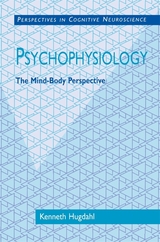 Psychophysiology: The Mind-Body Perspective
Kenneth Hugdahl
Harvard University Press, 1995 In our high-speed culture, terms like "stressed-out," "Type-A personality," "biofeedback," and "relaxation response" have become commonplaces. More than ever before, we are aware of the relationship between our mental and emotional states and our physical well-being. Findings from the field of psychophysiology, which investigates the reflexive interaction between psychology and physiology, have revised our approach to illness and its prevention and treatment. We know, for example, that stress, combined with other factors, increases vulnerability to heart attack and stroke. Successful treatment must include lifestyle changes to reduce the effects of stress on the body.
In this important text, Kenneth Hugdahl presents a comprehensive introduction to the history, methods, and applications of psychophysiology and explores other areas concerned with the "mind-body interface," such as psychosomatic medicine, behavioral medicine, clinical psychology, psychiatry, neuropsychology, and cognitive neuroscience. By showing how social, behavioral, cognitive, and emotional events are mirrored in physiological processes, he gives us a clearer understanding of complex cognitive processes.
This book illustrates psychophysiology's importance as a research and clinical tool and highlights its many contributions to the assessment and diagnosis of physical disorders. It also provides a framework for extending psychophysiological insights to other areas of psychology and neuroscience.
Psychopolitics: Conversations with Trevor Cribben Merrill
Jean-Michel Oughourlian
Michigan State University Press, 2012 For thousands of years, political leaders have unified communities by aligning them against common enemies. However, today more than ever, the search for “common” enemies results in anything but unanimity. Scapegoats like Saddam Hussein, for example, led to a stark polarization in the United States. Renowned neuropsychiatrist and psychologist Jean-Michel Oughourlian proposes that the only authentic enemy is the one responsible for both everyday frustrations and global dangers, such as climate change—ourselves. Oughourlian, who pioneered an “interdividual” psychology with René Girard, reveals how all people are bound together in a dynamic, contingent process of imitation, and shows that the same patterns of irrational mimetic desire that bring individuals together and push them apart also explain the behavior of nations.
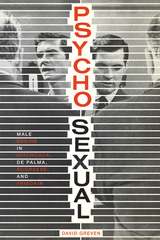 Psycho-Sexual: Male Desire in Hitchcock, De Palma, Scorsese, and Friedkin
By David Greven
University of Texas Press, 2013 Bridging landmark territory in film studies, Psycho-Sexual is the first book to apply Alfred Hitchcock’s legacy to three key directors of 1970s Hollywood—Brian De Palma, Martin Scorsese, and William Friedkin—whose work suggests the pornographic male gaze that emerged in Hitchcock’s depiction of the voyeuristic, homoerotically inclined American man. Combining queer theory with a psychoanalytic perspective, David Greven begins with a reconsideration of Psycho and the 1956 remake of The Man Who Knew Too Much to introduce the filmmaker’s evolutionary development of American masculinity. Psycho-Sexual probes De Palma’s early Vietnam War draft-dodger comedies as well as his film Dressed to Kill, along with Scorsese’s Taxi Driver and Friedkin’s Cruising as reactions to and inventive elaborations upon Hitchcock’s gendered themes and aesthetic approaches. Greven demonstrates how the significant political achievement of these films arises from a deeply disturbing, violent, even sorrowful psychological and social context. Engaging with contemporary theories of pornography while establishing pornography’s emergence during the classical Hollywood era, Greven argues that New Hollywood filmmakers seized upon Hitchcock’s radical decentering of heterosexual male dominance. The resulting images of heterosexual male ambivalence allowed for an investment in same-sex desire; an aura of homophobia became informed by a fascination with the homoerotic. Psycho-Sexual also explores the broader gender crisis and disorganization that permeated the Cold War and New Hollywood eras, reimagining the defining premises of Hitchcock criticism.
 Psychosis and Schizophrenia in Hong Kong: Navigating Clinical and Cultural Crossroads
Eric Yu Hai Chen and Yvonne Treffurth
Hong Kong University Press, 2024 Fills a gap in research by focusing psychosis studies on those affected in Hong Kong.
Psychosis and Schizophrenia in Hong Kong covers some of the most serious mental health conditions that top the global disease burden and affect three percent of the general population. However, most research on psychotic disorders is undertaken in the West, and few studies have been systematically carried out in Asia despite global interest in regional differences. This work offers a unique and coherent account of these disorders and their treatment in Hong Kong over the last thirty years.
Chen and his research program’s pioneering work has ranged from the impact of early intervention on outcomes and relapse prevention to the renaming of psychosis to reduce stigma. The studies have contributed to wider international debates on the optimal management of the condition. Their investigations in semantics and cognition, as well as cognition-enhancing exercise interventions, have provided novel insights into deficits encountered in the treatment of psychotic disorders and how they might be ameliorated. The research has also explored subjective experiences of psychosis and elicited unique perspectives in patients of Asian origin.
Each topic is divided into three sections: a global background of the challenges encountered; research findings from Hong Kong; and reflections that place the data in scientific and clinical contexts and offer future directions.
Psychosomatic Aspects of Gynecological Disorders: Seven Psychoanalytic Case Studies
Alfred O. Ludwig, Benjamin J. Murawski, and Somers H. Sturgis
Harvard University Press, 1969 This book is a preliminary effort in a largely uninvestigated area: the influence of emotional stress on functional disorder in gynecological cases. It summarizes detailed longitudinal studies during a minimum three-year period relating weekly measures of adrenal activity and psychological treatment in women seeking help for their menstrual and sexual difficulties. The findings will interest endocrinologists, psychoanalysts, gynecologists, psychologists, and psychophysiologists.
 Psychosomatic Families: Anorexia Nervosa in Context
Salvador Minuchin, Bernice L. Rosman, and Lester Baker
Harvard University Press, 1978 Salvador Minuchin is widely recognized as one of the preeminent family therapists in the world. He has been described, in the American Journal of Psychotherapy, as “a most original innovator, a superb clinician, and an outstanding teacher.” Now, in this pioneering work, he and his co-authors apply the effectiveness of family therapy techniques to an illness that has long resisted treatment—anorexia nervosa.
The purpose of their book is threefold: to develop a new theory of psychosomatic disease, to confirm it with scientific data, and to show it unfolding in actual therapeutic situations with anorectic patients. Drawing upon their own clinical experience and illustrating their views with case studies, they advance a new approach that places the locus of the illness not in the individual but in the family. Their method, which has been highly successful, requires the active involvement of the therapist as an agent of change within the family, stimulating crises that are severe enough to shake up the system and allow it to reform in new and healthier patterns.
This book has revolutionary implications, not just for anorectic patients but for those suffering from all other psychosomatic disease. Whereas such illnesses to date have often eluded treatment, the approach through family therapy holds out the promise of future successes.
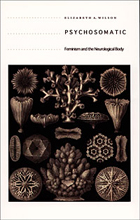 Psychosomatic: Feminism and the Neurological Body
Elizabeth A. Wilson
Duke University Press, 2004 How can scientific theories contribute to contemporary accounts of embodiment in the humanities and social sciences? In particular, how does neuroscientific research facilitate new approaches to theories of mind and body? Feminists have frequently criticized the neurosciences for biological reductionism, yet, Elizabeth A. Wilson argues, neurological theories—especially certain accounts of depression, sexuality, and emotion—are useful to feminist theories of the body. Rather than pointing toward the conventionalizing tendencies of the neurosciences, Wilson emphasizes their capacity for reinvention and transformation. Focusing on the details of neuronal connections, subcortical pathways, and reflex actions, she suggests that the central and peripheral nervous systems are powerfully allied with sexuality, the affects, emotional states, cognitive appetites, and other organs and bodies in ways not fully appreciated in the feminist literature. Whether reflecting on Simon LeVay’s hypothesis about the brains of gay men, Peter Kramer’s model of depression, or Charles Darwin’s account of trembling and blushing, Wilson is able to show how the neurosciences can be used to reinvigorate feminist theories of the body.
 Psychotherapy and Multiple Personality: Selected Essays
Morton Prince
Harvard University Press Morton Prince, a debonair Boston neurologist, established the modern American tradition of psychopathology and psychotherapy in the closing decade of the nineteenth century. Born in 1854, two years before Sigmund Freud and five years before Pierre Janet, he criticized and adapted their work to his own particular interests, which were primarily the exploration of hypnosis, multiple personality, and the unconscious. Prince informally headed the most sophisticated group of psychopathologists in the English-speaking world, which flourished in Boston and Cambridge beginning around 1890. He founded the Journal of Abnormal Psychology in 1906 and the American Psychopathological Association in 1910.
The essays in this volume have been chosen by Nathan G. Hale, Jr., to illustrate four major stages in Prince’s career. The first, from 1885 to 1898, saw his development of a dynamic psychotherapy, based on the existence of unconscious mental processes. During the second period, from 1898 through 1911, he made intensive studies of multiple personality. In the third, from 1909 through 1924, he confronted psychoanalysis and behaviorism. During the last period, from about 1914 through 1927, he published his final views of the unconscious, hypnotism, and personality.
Morton Prince’s observations remain important partly because they are so richly detailed, partly because of their dramatic and human interest, but chiefly because they shed light on phenomena that still defy final explanation.
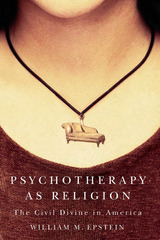 Psychotherapy As Religion: The Civil Divine In America
William M. Epstein
University of Nevada Press, 2006 A provocative look at America on the couch.In Psychotherapy as Religion, William Epstein sets out to debunk claims that psychotherapy provides successful clinical treatment for a wide range of personal and social problems. He argues that the practice is not a science at all but rather the civil religion of America, reflecting the principles of radical self-invention and self-reliance deeply embedded in the psyche of the nation. Epstein begins by analyzing a number of clinical studies conducted over the past two decades that purport to establish the effectiveness of psychotherapeutic treatments. He finds that each study violates in some way the standard criteria of scientific credibility and that the field has completely failed to establish objective procedures and measurements to assess clinical outcomes. Epstein exposes psychotherapy’s deep roots in the religious and intellectual movements of the early nineteenth century by demonstrating striking parallels between various types of therapy and such popular practices as Christian Science and spiritualism. Psychotherapy has taken root in our culture because it so effectively reflects our national faith in individual responsibility for social and personal problems. It thrives as the foundation of American social welfare policy, blaming deviance and misery on deficiencies of character rather than on the imperfections of society and ignoring the influence of unequal and deficient social conditions while requiring miscreants to undergo the moral reeducation that psychotherapy represents. This is a provocative, brilliantly argued look at America on the couch. Psychotherapy as Religion is essential reading for anyone interested in the history and current state of mental health.
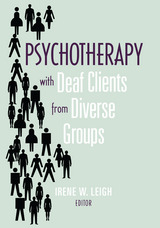 Psychotherapy with Deaf Clients from Diverse Groups
Irene W. Leigh
Gallaudet University Press, 1999 The second edition of Psychotherapy with Deaf Clients from Diverse Groups features the introduction of six new chapters that complement full revisions of original chapters with advances in the field since its initial publication. The first part begins with a new chapter on the current ethical issues relevant to working with deaf clients. In subsequent chapters it provides updated information on the diversity of consumer knowledge, attitudes, beliefs, and experiences. Deaf therapists and their involvement in the Deaf community also are scrutinized in this context. The revised second part examines psychotherapy for various constituencies, including deaf women; lesbian, gay, and bisexual deaf populations; children of deaf parents; and people with Usher syndrome. Part Three chapters consider interventions with African American deaf clients, American Indians who are deaf, and Asians who are American and deaf. A new chapter expands information on therapy for Latino deaf clients. The final section incorporates three new chapters on other deaf populations — deaf college students, recipients of cochlear implants, and deaf elderly clients. Also, new information has been added to chapters on the treatment of deaf survivors of sexual abuse and deaf clients with chemical dependency. The last addition to the second edition outlines dialectical behavior therapy for deaf clients, a valuable option for clinicians.
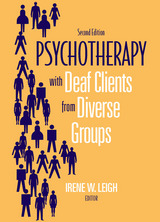 Psychotherapy with Deaf Clients from Diverse Groups
Irene W. Leigh
Gallaudet University Press, 2010 The second edition of Psychotherapy with Deaf Clients from Diverse Groups features the introduction of six new chapters that complement full revisions of original chapters with advances in the field since its initial publication. The first part begins with a new chapter on the current ethical issues relevant to working with deaf clients. In subsequent chapters it provides updated information on the diversity of consumer knowledge, attitudes, beliefs, and experiences. Deaf therapists and their involvement in the Deaf community also are scrutinized in this context.
The revised second part examines psychotherapy for various constituencies, including deaf women; lesbian, gay, and bisexual deaf populations; children of deaf parents; and people with Usher syndrome. Part Three chapters consider interventions with African American deaf clients, American Indians who are deaf, and Asians who are American and deaf. A new chapter expands information on therapy for Latino deaf clients.
The final section incorporates three new chapters on other deaf populations — deaf college students, recipients of cochlear implants, and deaf elderly clients. Also, new information has been added to chapters on the treatment of deaf survivors of sexual abuse and deaf clients with chemical dependency. The last addition to the second edition outlines dialectical behavior therapy for deaf clients, a valuable option for clinicians.
Pubis Angelical
Manuel Puig
University of Minnesota Press, 2000 A tale of intrigue and sexual entrapment. In this artful fusion of espionage thriller and science fiction, Manuel Puig tells one story shared by three women—an actress in the 1930s, living in her husband’s fairy-tale castle; a young woman in Mexico City in the 1970s, convalescing in a hospital; and a futuristic cyborg sex slave, occupying an artificial landscape. In the haunting and mysterious language for which he is renowned, Puig explores the links between these women, as well as the links between genders and generations. Best known for his novel Kiss of the Spider Woman, which has been adapted as a movie and a Broadway musical, Manuel Puig (1932–1990) also wrote Blood of Requited Love and Eternal Curse on the Reader of These Pages (both published by the University of Minnesota Press, 1999), as well as Betrayed by Rita Hayworth, Heartbreak Tango, and The Buenos Aires Affair.
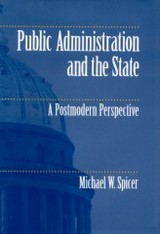 Public Administration and the State: A Postmodern Perspective
Michael W. Spicer
University of Alabama Press, 2005 A critical examination of public administration's pervasive vision of a powerful state Woodrow Wilson argued for a state led by a powerful government, guided by science and enlightened experts, for the accomplishment of a set of collective purposes—in other words, a purposive state. Michael Spicer contends that though Wilson and those who followed him have not typically explored questions of political and constitutional theory in their writing, a clear and strong vision of the state has emerged in their work nonetheless. Building upon the work of Dwight Waldo and others who have sought to explore and reveal the political theory behind the seemingly neutral language of administration, Spicer explores the roots—both historical and philosophical—of the purposive state. He considers the administrative experience of 18th-century Prussia and its relationship to the vision of the purposive state, and examines the ways this idea has been expressed in the 20th century. He then looks at the practical problems such a vision creates for public policy in a fragmented postmodern political culture. Finally, Spicer explores an alternative view of public administration—one based on a civil association model appropriate to our constitutional traditions and contemporary culture.
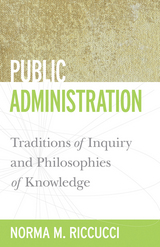 Public Administration: Traditions of Inquiry and Philosophies of Knowledge
Norma M. Riccucci
Georgetown University Press, 2010 Is public administration an art or a science? This question of whether the field is driven by values or facts will never be definitively answered due to a lack of consensus among scholars. The resulting divide has produced many heated debates; however, in this pioneering volume, Norma Riccucci embraces the diversity of research methods rather than suggesting that there is one best way to conduct research in public administration. Public Administration examines the intellectual origins and identity of the discipline of public administration, its diverse research traditions, and how public administration research is conducted today. The book’s intended purpose is to engage reasonable-minded public administration scholars and professionals in a dialogue on the importance of heterogeneity in epistemic traditions, and to deepen the field’s understanding and acceptance of its epistemological scope. This important book will provide a necessary overview of the discipline for graduate students and scholars.
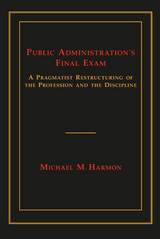 Public Administration's Final Exam: A Pragmatist Restructuring of the Profession and the Discipline
Michael M. Harmon
University of Alabama Press, 2006 Examines why public administration’s literature has failed to justify the profession’s legitimacy as an instrument of governance Michael Harmon employs the literary conceit of a Final Exam, first “written” in the early 1930s, in a critique of the field’s answers to the legitimacy question. Because the assumptions that underwrite the question preclude the possibility of a coherent answer, the exam should be canceled and its question rewritten. Envisaging a public administration no longer hostage to the legitimacy question, Harmon explains how the study and practice of public administration might proceed from adolescence to maturity. Drawing chiefly from pragmatist philosophy, he argues that despite the universal rejection of the “politics/administration” dichotomy on factual grounds, the pseudo-problem of legitimacy nonetheless persists in the guise of four related conceptual dualisms: 1) values and facts, 2) thinking and doing, 3) ends and means, and 4) theory and practice. Collectively, these dualisms demand an impossible answer to the practical question of how we might live, and govern, together in a world of radical uncertainty and interdependence. Only by dissolving them can the legitimacy question (Woodrow Wilson’s ghost) finally be banished, clearing away the theoretical debris that obscures a more vital and useful conception of governance.
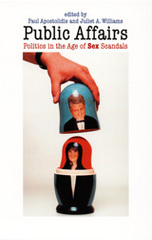 Public Affairs: Politics in the Age of Sex Scandals
Paul Apostolidis and Juliet A. Williams, eds.
Duke University Press, 2004 Public affairs—or sex scandals—involving prominent politicians are as revealing of American culture as they are of individual peccadillos. Implicated in their unfolding are a broad range of institutions, trends, questions, and struggles, including political parties, Hollywood, the Christian right, new communications technologies, the restructuring of corporate media, feminist and civil rights debates, and the meaning of public life in the “society of the spectacle.” The contributors to Public Affairs examine, from a variety of perspectives, how political sex scandals take shape, gain momentum, and alter the U.S. political and cultural landscape. The essays in Public Affairs reflect on a number of sex scandals while emphasizing the Clinton/Lewinsky affair, certainly the most avidly followed and momentous sex scandal in American political history. Leading scholars situate contemporary public affairs in the context not only of earlier sex scandals in American politics (such as Thomas Jefferson’s and Sally Hemings’s affair), but also of more purely political scandals (including Teapot Dome and Watergate) and sex scandals centered around public figures other than politicians (such as the actor Hugh Grant and the minister Jimmy Swaggart). Some essays consider the Clinton affair in light of feminist and anti-racist politics, while others discuss the dynamics of scandals as major media events. By charting a critical path through the muck of scandal rather than around it, Public Affairs illuminates why sex scandals have become such a prominent feature of American public life. Contributors. Paul Apostolidis, Jodi Dean, Joshua Gamson, Theodore J. Lowi, Joshua D. Rothman, George Shulman, Anna Marie Smith, Jeremy Varon, Juliet A. Williams
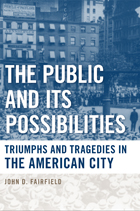 The Public and Its Possibilities: Triumphs and Tragedies in the American City
John D. Fairfield
Temple University Press, 2012 In his compelling reinterpretation of American history, The Public and Its Possibilities, John Fairfieldargues that our unrealized civic aspirations provide the essential counterpoint to an excessive focus on private interests. Inspired by the revolutionary generation, nineteenth-century Americans struggled to build an economy and a culture to complement their republican institutions. But over the course of the twentieth century, a corporate economy and consumer culture undercut civic values, conflating consumer and citizen. Fairfield places the city at the center of American experience, describing how a resilient demand for an urban participatory democracy has bumped up against the fog of war, the allure of the marketplace, and persistent prejudices of race, class, and gender. In chronicling and synthesizing centuries of U.S. history—including the struggles of the antislavery, labor, women’s rights movements—Fairfield explores the ebb and flow of civic participation, activism, and democracy. He revisits what the public has done for civic activism, and the possibility of taking a greater role. In this age where there has been a move towards greater participation in America's public life from its citizens, Fairfield’s book—written in an accessible, jargon-free style and addressed to general readers—is especially topical.
The Public and Its Problems: An Essay in Political Inquiry
John Dewey
Ohio University Press, 2016 More than six decades after John Dewey’s death, his political philosophy is undergoing a revival. With renewed interest in pragmatism and its implications for democracy in an age of mass communication, bureaucracy, and ever-increasing social complexities, Dewey’s The Public and Its Problems, first published in 1927, remains vital to any discussion of today’s political issues. This edition of The Public and Its Problems, meticulously annotated and interpreted with fresh insight by Melvin L. Rogers, radically updates the previous version published by Swallow Press. Rogers’s introduction locates Dewey’s work within its philosophical and historical context and explains its key ideas for a contemporary readership. Biographical information and a detailed bibliography round out this definitive edition, which will be essential to students and scholars both.
 Public and Private: Gender, Class, and the British Novel (1764-1878)
Patricia McKee
University of Minnesota Press, 1997 Public and Private was first published in 1997. Minnesota Archive Editions uses digital technology to make long-unavailable books once again accessible, and are published unaltered from the original University of Minnesota Press editions. This groundbreaking work examines the emergent and fluctuating relationship between the public and private social spheres of the late eighteenth and nineteenth centuries. By assessing novels such as Mary Shelley's Frankenstein and Jane Austen's Emma through the lens of the social theories of Jürgen Habermas and Michel Foucault, Patricia McKee presents a fresh and highly original contribution to literary studies. McKee explores the themes of production and consumption as they relate to gender and class throughout the works of many of the most influential novels of the age including Tobias Smollett's Humphry Clinker, Horace Walpole's The Castle of Otranto, Emma, Frankenstein, Anthony Trollope's Barchester Towers, Charles Dickens's Little Dorrit and The Old Curiosity Shop, Mrs. Henry Wood's East Lynne, and Thomas Hardy's The Return of the Native. McKee analyzes portrayals of a society in which abstract idealism belonged to knowledgeable, productive men and the realm of ignorance was left to emotional, consuming women and the uneducated. She traces the various ways British literature of the eighteenth and nineteenth centuries worked to reform this social experience. Topics include Dickens's attack on the bureaucratic use of knowledge to maintain the status quo; the function of antiprogressive depictions of knowledge in Trollope, Shelley, and Hardy; and Austen's characterization of the protagonist Emma as an exception in a society that denied women's productive use of knowledge. Offering a sharp challenge to theorists who have charted a linear division of public and private experience, McKee highlights the unexpected configurations of the emergence of the public and private spheres and the effect of knowledge distribution across class and gender lines. Patricia McKee is professor of English at Dartmouth College. She is the author of Heroic Commitment in Richardson, Eliot, and James (1986).
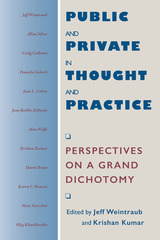 Public and Private in Thought and Practice: Perspectives on a Grand Dichotomy
Edited by Jeff Weintraub and Krishan Kumar
University of Chicago Press, 1997 These essays, by widely respected scholars in fields ranging from social and political theory to historical sociology and cultural studies, illuminate the significance of the public/private distinction for an increasingly wide range of debates. Commenting on controversies surrounding such issues as abortion rights, identity politics, and the requirements of democratization, many of these essays clarify crucial processes that have shaped the culture and institutions of modern societies.
In contexts ranging from friendship, the family, and personal life to nationalism, democratic citizenship, the role of women in social and political life, and the contrasts between western and (post-)Communist societies, this book brings out the ways the various uses of the public/private distinction are simultaneously distinct and interconnected. Public and Private in Thought and Practice will be of interest to students and scholars in disciplines including politics, law, philosophy, history, sociology, and women's studies.
Contributors include Jeff Weintraub, Allan Silver, Craig Calhoun, Daniela Gobetti, Jean L. Cohen, Jean Bethke Elshtain, Alan Wolfe, Krishan Kumar, David Brain, Karen Hansen, Marc Garcelon, and Oleg Kharkhordin.
 Public Budgeting in the United States: The Cultural and Ideological Setting
Steven G. Koven
Georgetown University Press, 1999 Budgeting has long been considered a rational process using neutral tools of financial management, but this outlook fails to consider the outside influences on leaders’ behavior. Steven G. Koven shows that political culture (moralistic, traditionalistic, individualistic) and ideological orientations (liberal vs. conservative) are at least as important as financial tools in shaping budgets. Koven examines budget formation at the national, state, and local levels to demonstrate the strong influence of attitudes about how public money should be generated and spent. In addition to statistical data, the book includes recent case studies: the 1997 budget agreement; Governor George W. Bush’s use of the budget process to advance a conservative policy agenda in the state of Texas; and Mayor Marion Barry’s abuses of power in Washington, D.C. Koven demonstrates that administrative principles are at best an incomplete guide for public officials and that budgeters must learn to interpret signals from the political environment.
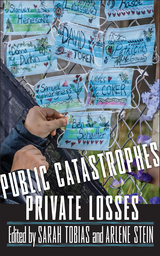 Public Catastrophes, Private Losses
Sarah Tobias
Rutgers University Press, 2025 From COVID to climate-change-induced wildfires and hurricanes, we live in an era when catastrophes have become the new normal. But even though these events affect us all, some members of society are more vulnerable to harm than others.
This essay collection explores how the definition of catastrophe might be expanded to include many forms of large-scale structural violence on communities, species, and ecosystems. Using feminist methodologies, the contributors to Public Catastrophes, Private Losses trace the connections between seemingly unrelated forms of violence such as structural racism, environmental degradation, and public health crises. In contrast to a news media that focuses on mass fatalities and immediate consequences, these essays call our attention to how catastrophes can also involve slow violence with long-term effects.
The authors also consider how these catastrophes are profoundly shaped by government action or inaction, offering a powerful critique of how government neglect has cost lives and demonstrating how vulnerable populations can be better protected. The essays in this collection examine how public catastrophes imprint themselves on lives, as individuals and communities narrate, process, and grapple with legacies of loss. The book is thus a feminist intervention that challenges the binary between public and private, personal and political.
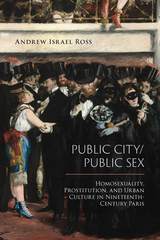 Public City/Public Sex: Homosexuality, Prostitution, and Urban Culture in Nineteenth-Century Paris
Andrew Israel Ross
Temple University Press, 2019 In the 1800s, urban development efforts modernized Paris and encouraged the creation of brothels, boulevards, cafés, dancehalls, and even public urinals. However, complaints also arose regarding an apparent increase in public sexual activity, and the appearance of “individuals of both sexes with depraved morals” in these spaces. Andrew Israel Ross’s illuminating study, Public City/Public Sex, chronicles the tension between the embourgeoisement and democratization of urban culture in nineteenth-century Paris and the commercialization and commodification of a public sexual culture, the emergence of new sex districts, as well as the development of gay and lesbian subcultures. Public City/Public Sex examines how the notion that male sexual desire required suitable outlets shaped urban policing and development. Ross traces the struggle to control sex in public and argues that it was the very effort to police the city that created new opportunities for women who sold sex and men who sought sex with other men. Placing public sex at the center of urban history, Ross shows how those who used public spaces played a central role in defining the way the city was understood.
Public Debate in the Civil War Era: A Rhetorical History of the United States, Volume IV
David Zarefsky
Michigan State University Press, 2023 Public debate and discussion was overshadowed by the slavery controversy during the period of the U.S. Civil War. Slavery was attacked, defended, amplified, and mitigated. This happened in the halls of Congress, the courts, the political debate, the public platform, and the lecture hall. This volume examines the issues, speakers, and venues for this controversy between 1850 and 1877. It combines exploration of the broad contours of controversy with careful analysis of specific speakers and texts.
Public Diplomacy in Ireland and Japan
John Neary
Amsterdam University Press, 2024 Public diplomacy enables private citizens to be involved in international relations either through initiatives sponsored by governments or through direct people-to-people contacts in areas such as culture, business, education, tourism and sport. Public Diplomacy in Ireland and Japan traces the evolution of this growing branch of diplomacy and examines the role it has played in the foreign policies of Ireland and Japan, and in their bilateral relationship. It concludes that public diplomacy has contributed significantly to strengthening the links between the two countries.
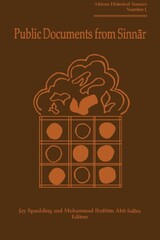 Public Documents from Sinnar
Jay Spaulding
Michigan State University Press, 1989 This selection of Arabic and English translations illuminates the changes of eighteenth-century government in the northern Nile Valley of Sudan, and provides reliable chronological points of reference for the history of the region.
The documents offered in this volume, including charter grants of land and privilege, administrative letters, judicial rulings, and other official government records, date form 1702 to 1820. This period marks the apogee of the wealth, power, and geographical extent of the realm of the Funji kings of Sinnar who reigned over much of the Sudan from about 1500 until the Turkish colonial conquest of 1821.
These records document with concrete precision and eloquence the dissolution of the agrarian social order of an old African kingdom under the corroding influence of intrusive Mediterranean commercial practices and culture. They reveal the Sudan's legacy of a traditionally weak government vulnerable to manipulation or conquest by foreign powers and a divided and impoverished society dominated by a minority of urban interests.
Public Dollars, Private Stadiums: The Battle over Building Sports Stadiums
Delaney, Kevin J.
Rutgers University Press, 2003 The authors provide an eye-opening account of recent battles over publicly financed stadiums in some of America’s largest cities. Their interviews with the key decision makers present a behind-the-scenes look at how and why powerful individuals and organizations foist these sports palaces on increasingly unreceptive communities. Delaney and Eckstein show that in the face of studies demonstrating that new sports facilities don’t live up to their promise of big money, proponents are using a new tactic to win public subsidies¾intangible “social” rewards, such as prestige and community cohesion. The authors find these to be empty promises as well, demonstrating that new stadiums may exacerbate, rather than erase, social problems in cities.
Public Education: An Autopsy
Myron Lieberman
Harvard University Press, 1993 In this blistering critique of our failing public schools and our fuzzy thinking about how to fix them, Myron Lieberman explains why public education is in irreversible and terminal decline and tells us what we must do to get American schooling back on track. No other book on educational policy or reform covers such a broad range of issues or draws upon such extensive empirical data across such diverse academic disciplines. This is a refreshingly clear analysis of our educational crisis and a rallying cry for market-system approaches to school reform. Nobody emerges unscathed—Lieberman’s analysis challenges the advocates of choice as well as the defenders of the public schools.
 Public Education and Social Reform: A History of the Illinois Education Association
Thomas J. Suhrbur
University of Illinois Press, 2025 Founded in 1853, the Illinois Education Association (IEA) and its predecessors have played a vital role in shaping the Illinois public school system. Thomas J. Suhrbur’s history covers the lifespan of the IEA within the larger story of state public education as a battleground for contentious social and economic issues. Suhrbur pays particular attention to the impact of race, gender, religion, and tax policy on the IEA and public schools. He also examines the IEA’s evolution from a professional organization controlled by administrations and officials through its radical transformation into a teacher-led independent labor union. As a workers’ organization, the IEA successfully fought for collective bargaining and organized K–12 and higher education while continually standing against right-wing efforts to privatize education and undermine public schools with vouchers, for-profit institutions, and tax credits. Multifaceted and up to date, Public Education and Social Reform tells the story of the organization and figures dedicated to sustaining and advancing Illinois public education.
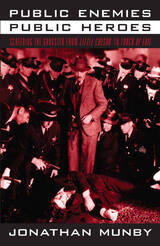 Public Enemies, Public Heroes: Screening the Gangster from Little Caesar to Touch of Evil
Jonathan Munby
University of Chicago Press, 1999 In this study of Hollywood gangster films, Jonathan Munby examines their controversial content and how it was subjected to continual moral and political censure.
Beginning in the early 1930s, these films told compelling stories about ethnic urban lower-class desires to "make it" in an America dominated by Anglo-Saxon Protestant ideals and devastated by the Great Depression. By the late 1940s, however, their focus shifted to the problems of a culture maladjusting to a new peacetime sociopolitical order governed by corporate capitalism. The gangster no longer challenged the establishment; the issue was not "making it," but simply "making do."
Combining film analysis with archival material from the Production Code Administration (Hollywood's self-censoring authority), Munby shows how the industry circumvented censure, and how its altered gangsters (influenced by European filmmakers) fueled the infamous inquisitions of Hollywood in the postwar '40s and '50s by the House Committee on Un-American Activities. Ultimately, this provocative study suggests that we rethink our ideas about crime and violence in depictions of Americans fighting against the status quo.
The Public Enemy
Edited by Henry Cohen; Tino T. Balio, Series Editor
University of Wisconsin Press, 1981 The Public Enemy, a 1931 Warner Brothers gangster classic, is easily remembered as the movie in which James Cagney used Mae Clarke's nose as a grapefruit grinder. As Cagney recalls, it was just about the first time that "a woman had been treated like a broad on the screen, instead of like a delicate flower."
The ambivalence toward women is just one of the many stylistic contradictions that make The Public Enemy worth studying, not only for its intrinsic merits but also as a creative expression bending under the constraints of censorship.
 Public Engagement in the European Middle Ages: Medieval Solutions for a Modern Crisis
Christopher D. Fletcher
Arc Humanities Press, 2025 This manual uses the medieval past to teach modern scholars how to succeed in public engagement. Combining a careful study of public engagement in Europe between 1000 and 1500 with the author’s experiences working at a public research library, this book shows medievalists how to use mindsets, approaches, and practices from the Middle Ages to build productive connections with diverse publics beyond academia. To do so, it describes the systemic roadblocks preventing effective public engagement in the academy; offers four medieval solutions to those issues from the work of prominent intellectuals and anonymous laypeople from medieval Europe; and suggests how scholars can incorporate those solutions into their professional development. In so doing, this book will help present and future generations of professional medievalists to make their expertise engaging, relevant, and valuable for contemporary audiences of all kinds.
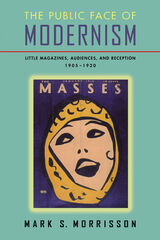 Public Face Of Modernism: Little Magazines, Audiences, And Reception, 1905-1920
Mark S. Morrisson
University of Wisconsin Press, 2000 Between the 1890s and the 1920s, mass consumer culture and modernism grew up together, by most accounts as mutual antagonists. This provocative work of cultural history tells a different story. By delving deeply into the publishing and promotional practices of the modernists in Britain and America, however, Mark Morrisson reveals that their engagements with the commercial mass market were in fact extensive and diverse.
The phenomenal successes of new advertising agencies and mass market publishers did elicit what Morrisson calls a "crisis of publicity" for some modernists and for many concerned citizens in both countries. But, as Morrisson demonstrates, the vast influence of these industries on consumers also had a profound and largely overlooked effect upon many modernist authors, artists, and others. By exploring the publicity and audience reception of several of the most important modernist magazines of the period, The Public Face of Modernism shows how modernists, far from lamenting the destruction of meaningful art and public culture by the new mass market, actually displayed optimism about the power of mass-market technologies and strategies to transform and rejuvenate contemporary culture—and, above all, to restore a public function to art.
This reconstruction of the "public face of modernism" offers surprising new perceptions about the class, gender, racial, and even generational tensions within the public culture of the early part of the century, and provides a rare insight into the actual audiences for modernist magazines of the period. Moreover, in new readings of works by James Joyce, George Bernard Shaw, Wyndham Lewis, Ford Madox Ford, T. S. Eliot, William Carlos Williams, and many others, Morrisson shows that these contexts also had an impact on the techniques and concerns of the literature itself.
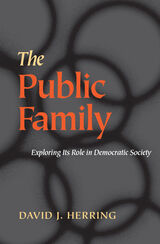 The Public Family: Exploring Its Role In Democratic Societies
David J. Herring
University of Pittsburgh Press, 2003
Those concerned with investigating the political functions of the family far too often identify only one: the production of “good democratic citizens.” As a result, public discussion of family law and policy has been confined to a narrow continuum that ignores the family's other, often subversive, political functions.
In The Public Family David Herring's goal is to create a new rhetoric that moves beyond the stalemate that often results from the war between advocates of parental rights and those of children's rights. This “rhetoric of associational respect” allows him to constructively address the role of rights and the limits of individualism in political and legal theory.
While acknowledging the family's importance in facilitating state functioning and power in a large, pluralistic democracy (the aforementioned production of good citizens), Herring fully explores the ways in which the family produces diversity and promotes tolerance. Unlike other works on the subject, which view the differences between individuals as constituting the central challenge for American society, Herring focuses on the importance of such differences. In doing so, he enriches and enlivens the often divisive public discussion of family law and policy.
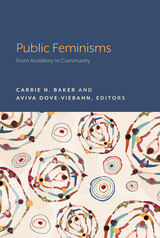 Public Feminisms: From Academy to Community
Edited by Carrie N. Baker and Aviva Dove-Viebahn
Lever Press, 2023 The field of feminist studies grew from the U.S. women’s movements of the 1960s and 1970s and has continued to be deeply connected to ongoing movements for social justice. As educational institutions are increasingly seeing public scholarship and community engagement as relevant and fruitful complements to traditional academic work, feminist scholars have much to offer in demonstrating different ways to inform and interact with various communities. In Public Feminisms: From Academy to Community edited by Carrie N. Baker and Aviva Dove-Viebahn, a diverse range of feminist scholar-activists write about the dynamic and varied methods they use to reach beyond the traditional academic classroom and scholarly journals to share their work with the public. Part one explores how feminist scholars engage broader audiences through art, media, and public programming, including essays on a public discussion series teaching intersectional feminist analysis of popular films, and a podcast from Latina scholars discussing issues of reproductive justice, social justice, motherhood, sexuality, race, and gender. Part two focuses on activism and public education, including essays on “Take Back the Night,” and archiving the women’s march protests. Part three turns to public writing and scholarship, including an essay on elevating the perspectives and voices of underrepresented creatives in the film and television industry. Part four explores feminist pedagogies for community engagement and for teaching public feminisms. Accessible and engaging to a broad range of readers, the essays in this volume are a rich resource for scholars and students interested in infusing their academic knowledge into the public sphere. With this timely book, the editors offer an opportunity to reflect on the meaning and importance of community engagement and highlight some of the important public-facing work feminist scholars are doing today. Faculty, graduate, and undergraduate students, as well as administrators hoping to increase their schools’ connections to the community, will find this volume indispensable.
Public Finance During the Korean Modernization Process
Roy Bahl, Chuk Kyo Kim, and Chong Kee Park
Harvard University Press, 1986 This final volume in the series Studies in the Modernization of the Republic of Korea, 1945–1975, is an analysis of the contribution of tax and expenditure policy to Korea's rapid economic development during the 1953–1975 period. Based upon specially compiled and comprehensive revenue and expenditure data, the authors first trace the history of Korean fiscal policy during the modernization period and then examine how Korea's fiscal development has differed from that of other countries. The results of the analysis show that Korea did not follow the traditional path of a steadily increasing tax effort, reliance on direct taxes, and emphasis on income distribution. Instead, through improved tax administration and expenditure control, the savings rate was increased dramatically.
Public Financing in American Elections
Edited by Costas Panagopoulos
Temple University Press, 2011 Reformers argue that public financing of campaigns will help rescue American democracy from the corruptive influence of money in elections. Public Financing in American Elections evaluates this claim and aims to remove much of the guesswork from the discussion about public finance. Featuring some of the most senior scholars in political science and electoral studies, this book provides an up-to-date treatment of campaign finance research and thinking about public campaign financing reforms. Exploring proposals at the local, state, and federal levels, the contributors provide a comprehensive overview of public financing initiatives in the United States and discuss their impact. Focused analyses of several current public programs are also presented.
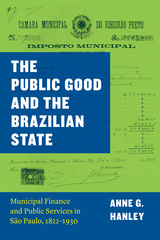 The Public Good and the Brazilian State: Municipal Finance and Public Services in São Paulo, 1822–1930
Anne G. Hanley
University of Chicago Press, 2018 Who and what a government taxes, and how the government spends the money collected, are questions of primary concern to governments large and small, national and local. When public revenues pay for high-quality infrastructure and social services, citizens thrive and crises are averted. When public revenues are inadequate to provide those goods, inequality thrives and communities can verge into unrest—as evidenced by the riots during Greece’s financial meltdown and by the needless loss of life in Haiti’s collapse in the wake of the earthquake.
In The Public Good and the Brazilian State, Anne G. Hanley assembles an economic history of public revenues as they developed in nineteenth-century Brazil. Specifically, Hanley investigates the financial life of the municipality—a district comparable to the county in the United States—to understand how the local state organized and prioritized the provision of public services, what revenues paid for those services, and what happened when the revenues collected failed to satisfy local needs. Through detailed analyses of municipal ordinances, mayoral reports, citizen complaints, and financial documents, Hanley sheds light on the evolution of public finance and its effect on the early economic development of Brazilian society. This deeply researched book offers valuable insights for anyone seeking to better understand how municipal finance informs histories of inequality and underdevelopment.
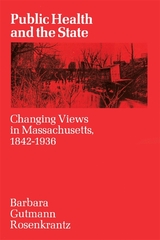 Public Health and the State: Changing Views in Massachusetts. 1842-1936
Barbara Rosenkrantz
Harvard University Press, 1972 Public Health and the State constitutes both a fine piece of social history and an ideal model for evaluating our current definition of public health. In this thought-provoking account, Ms. Rosenkrantz perceptively traces the development of the Massachusetts State Board of Health--established in 1869 as the first state institution in the United States responsible for preventing unnecessary mortality and promoting all aspects of public health.
This study describes the areas in which state responsibility for deterring disease assumed increased authority after the Civil War. It begins at a time when the definition of health' implied that it could be achieved, supported by the perfectionist belief that a healthy populace--obedient to the laws of nature--guaranteed a sound society. As rapid urban and industrial growth began to sweep the country, however, there was an expressed concern that this expansion threatened the health and morals of the people. During this period, when the etiology of disease was ascribed to a variety of environmental and behavioral factors, the Massachusetts Board developed a comprehensive program of investigation and advice on such diverse issues as housing, water supplies, slaughterhouse conditions, and the use of alcohol.
Later, as specific medical prophylaxis and therapy came to characterize public health policy, the relationship between sanitary science and social reform was redefined by both professional standards and public expectation. The State Board depended less and less upon its ability to influence individual conduct. Laboratory scientists, chemists, and physicians, who tended to describe disease in biological terms, directed public health toward science.
In view of pressing public health problems posed by such hazards as drug abuse and environmental pollution, Ms. Rosenkrantz warns us that it is as important to identify the origins of the social and scientific assumptions regarding public health as it is to discover the biological etiology of disease. The last chapter of Public Health and the State suggests that the goal of perfect health, based upon the ideal concepts of the past, may no longer be a viable objective. For these reasons she views the development of the Massachusetts State Board of Health as "the story of a successful endeavor that can never be re-enacted."
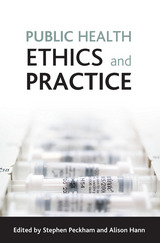 Public health ethics and practice
Edited by Stephen Peckham and Alison Hann
Bristol University Press, 2009 Ethical dilemmas are not new in the area of health care and policy making, but in recent years, their frequency and diversity have grown considerably. All health professionals now have to consider the ethical implications of an increasing array of treatments, interventions and health promotion activities on an almost daily basis. This goes hand in hand with increasing medical knowledge, and the growth of new and innovative medical technologies and pharmaceuticals. In addition, the same technology and knowledge is increasing professional and public awareness of new potential public health threats (e.g. pandemic influenza). At the level of public policy, concerns over the rising costs of health care have led to a more explicit focus on 'health promotion', and the surveillance of both 'patients' and the so-called 'worried well'. Health professionals and policy makers also have to consider the implications of managing these risks, for example restricting individual liberty through enforced quarantine (in the wake of SARS and more recently swine flu) and the more general distribution of harms and benefits. Balancing the rights and responsibilities of individuals and wider populations is becoming more complex and problematic. This book will play a key role in opening out a discussion of public health ethics. It examines the principles and values that support an ethical approach to public health practice and provides examples of some of the complex areas which those practising, analysing and planning the health of populations have to navigate. It will therefore be essential reading for current practitioners, those involved in public health research and a valuable aid for anyone interested in examining the tensions within and the development of public health.
Public Health in Asia during the COVID-19 Pandemic: Global Health Governance, Migrant Labour, and International Health Crises
Anoma van der Veere
Amsterdam University Press, 2022 Asian countries have dealt with COVID-19 with varying levels of success. The WHO’s lack of effective leadership in the region has resulted in increasingly contested global health governance. The pandemic continues to undermine global health, and the highly interdependent economies in Asia have exposed the speed with which pandemics can now spread. The security of migrant workers is more precarious than ever. Millions have been stranded and face limited access to health services. Public Health in Asia during the COVID-19 Pandemic: Global Health Governance, Migrant Labour, and International Health Crises provides an accessible framework for understanding the COVID-19 pandemic in Asia through the lens of global governance in health and labour.
 Public Health in the Town of Boston, 1630–1822
John B. Blake
Harvard University Press In this book, based almost exclusively on original source material, Dr. Blake takes a detailed look at the public health history of the town of Boston. Historically, the author tells us, public health may be viewed as the science and art of preventing disease and promoting health through organized community activity. A significant part of this study is the insight it offers into the early attitudes toward disease and death as well as other basic political, social, and economic questions.
Dr. Blake outlines the development of public health practice from occasional emergency measures to a continuing program for the prevention and control of certain epidemic diseases. The introduction and increasing use of smallpox inoculation and later of vaccination are described and their importance evaluated. The book also discusses the further developments in the 1790s and the following two decades that resulted from a series of yellow-fever epidemics in northern seaports, including the establishment of a board of health and its efforts to prevent recurrence of this disease. The prevention of other endemic infectious diseases, though far more important in their effect on the community’s health, was largely neglected. Nevertheless, the principles of notification, isolation, and quarantine had been established and the need for governmental activity to protect the public health, for special public health officials, and for expenditure of tax money for public health purposes had been recognized.
This study, restricted in time to the period before Boston became a city (1630–1822), deals with the early years of the public health movement, a period that has been largely neglected. In comparing Boston’s experience with that of other colonies and England, Dr. Blake presents the European background in both the theory and practice of epidemiology and public health. The colonies themselves, whose differences caused many contemporaries to despair of their ever becoming a single nation, were yet bound by an essential homogeneity. “By and large they had the same language, the same religion, the same inheritance of British social and political ideals. And by and large they had the same diseases. Thus the history of public health in Boston becomes significant for the whole American experience.”
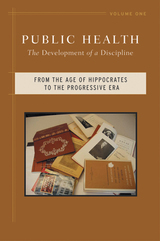 Public Health: The Development of a Discipline, From the Age of Hippocrates to the Progressive Era
Schneider, Dona
Rutgers University Press, 2008 Public health as a discipline grew out of traditional Western medicine but expanded to include interests in social policy, hygiene, epidemiology, infectious disease, sanitation, and health education. This book, the first of a two-volume set, is a collection of important and representative historical texts that serve to trace and to illuminate the development of conceptions, policies, and treatments in public health from the dawn of Western civilization through the Progressive Era of the early twentieth century.
The editors provide annotated readings and biographical details to punctuate the historical timeline and to provide students with insights into the progression of ideas, initiatives, and reforms in the field. From Hippocrates and John Graunt in the early period, to John Snow and Florence Nightingale during the nineteenth-century sanitary reform movement, to Upton Sinclair and Margaret Sanger in the Progressive Era, readers follow the identification, evolution, and implementation of public health concepts as they came together under one discipline.
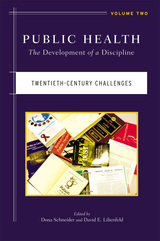 Public Health: The Development of a Discipline, Twentieth-Century Challenges
Schneider, Dona
Rutgers University Press, 2011 Published in 2008, the first volume of Public Health focused on issues from the dawn of western civilization through the Progressive era. Volume 2 defines the public health challenges of the twentieth century--this important reference covers not only how the discipline addressed the problems of disease, but how it responded to economic, environmental, occupational, and social factors that impacted public health on a global scale. Major illnesses such as cancer, HIV, and tuberculosis are addressed, along with lifestyle concerns, such as tobacco and nutrition. Chapters also explore maternal-child and women's health, dental public health, health economics and ethics, and the role of philanthropy. Each chapter begins with an in-depth introduction, followed by three original articles that illustrate the problem. The volume is enhanced with a detailed chronology of public health events, as well as appendices that contain many of the original documents that ushered public health into the new millennium.
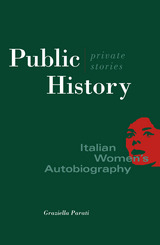 Public History, Private Stories: Italian Women’s Autobiography
Graziella Parati
University of Minnesota Press, 1996 Explores the way Italian women writers craft identities through writing. In this important volume, Graziella Parati examines the ways in which Italian women writers articulate their identities through autobiography—a public act that is also the creation of a private life. Considering autobiographical writings by five women writers from the seventeenth century to the present, Parati draws important connections between self-writing and the debate over women’s roles, both traditional and transgressive. Parati considers the first prose autobiography written by an Italian woman -Camilla Faà Gonzaga’s 1622 memoir—as her beginning point, citing it as a central “pre-text.” In her memoir, Gonzaga makes explicit her conflict over the public silence imposed on her, yet succeeds in writing herself into history through self-narrative. Parati then examines Enif Robert’s autobiography, in which Robert strives to enter the public sphere of the post-World War I futurist movement by writing about her fight to overcome cancer of the uterus. Next, Parati considers Fausta Cialente’s life story, an account of her family's life in Trieste from World War I through the fascist era, as well as the narrative in which Rita Levi Montalcini describes her life as a woman, a Nobel-Prize winning scientist, and a Jew who lived under fascism in the thirties and forties. Finally, Parati analyzes Luisa Passerini's look back on her involvement with the student movement of 1968. Through her discussion of these women’s writings, Parati demonstrates the complex negotiations over identity contained within them, negotiations that challenge dichotomies between male and female, maternal and paternal, and private and public. Public History, Private Stories is a compelling exploration of the disparate identities created by these women through the act of writing autobiography.
Public Humanities: Engaging Community, Empowering Civic Discourse, and Reshaping Academia
Molly Todd
Michigan State University Press, 2025 Engaged public scholarship is transforming the humanities. Divided into four parts, this provocative volume examines historical and contemporary sites of education and pedagogy, challenges dominant narratives about certain symbolic sites in the United States and across the Americas, highlights the struggle of marginalized communities as they wrestle to rewrite individual and collective memories of violence and trauma, and features public humanities projects that address themes relating to place and environment. Each chapter is concerned with the importance of personal relationships in educational settings, power relations in public humanities projects, and the nurturing of “new” civic spaces and places. This volume makes an important contribution to timely debates about public-facing and publicly engaged scholarship, especially in the humanities.
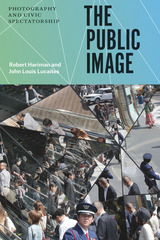 The Public Image: Photography and Civic Spectatorship
Robert Hariman and John Louis Lucaites
University of Chicago Press, 2016 Even as the media environment has changed dramatically in recent years, one thing at least remains true: photographs are everywhere. From professional news photos to smartphone selfies, images have become part of the fabric of modern life. And that may be the problem. Even as photography bears witness, it provokes anxieties about fraudulent representation; even as it evokes compassion, it prompts anxieties about excessive exposure. Parents and pundits alike worry about the unprecedented media saturation that transforms society into an image world. And yet a great news photo can still stop us in our tracks, and the ever-expanding photographic archive documents an era of continuous change.
By confronting these conflicted reactions to photography, Robert Hariman and John Louis Lucaites make the case for a fundamental shift in understanding photography and public culture. In place of suspicions about the medium’s capacity for distraction, deception, and manipulation, they suggest how it can provide resources for democratic communication and thoughtful reflection about contemporary social problems.
The key to living well in the image world is to unlock photography from viewing habits that inhibit robust civic spectatorship. Through insightful interpretations of dozens of news images, The Public Image reveals how the artistry of the still image can inform, challenge, and guide reflection regarding endemic violence, environmental degradation, income inequity, and other chronic problems that will define the twenty-first century.
By shifting from conventional suspicions to a renewed encounter with the image, we are challenged to see more deeply on behalf of a richer life for all, and to acknowledge our obligations as spectators who are, crucially, also citizens.
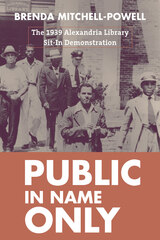 Public in Name Only: The 1939 Alexandria Library Sit-In Demonstration
Brenda Mitchell-Powell
University of Massachusetts Press, 2022 Library History Round Table Reads Selection, March 2024
Alexandria Historical Society Special Merit Award, 2023
When Alexandria, Virginia’s first public library, was constructed just a few blocks from his home, Samuel Wilbert Tucker, a young, Black attorney, was appalled to learn that he could not use the library because of his race. Inspired by the legal successes of the NAACP in discrimination cases, he organized a grassroots protest to desegregate the library that his tax dollars supported. Public in Name Only tells the important, but largely forgotten, story of Tucker and a group of Black citizens who agitated for change in the terms and conditions of their lives. Employing the combined strategies of direct-action public protest, nonviolent civil disobedience, and municipal litigation, Tucker’s initiative dovetailed with the national priorities and tactics of larger civil rights organizations. While Tucker’s campaign did not end with the desegregation of the Alexandria Library, but instead resulted in the creation of a “separate-and-unequal” Jim Crow Black branch, the sit-in demonstration represents a momentous early struggle for racial equity waged through civil rights activism.
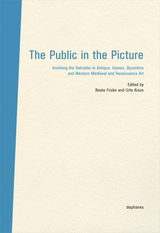 The Public in the Picture: Involving the Beholder in Antique, Islamic, Byzantine, Western Medieval and Renaissance Art
Edited by Beate Fricke and Urte Krass
Diaphanes, 2015 The act of including bystanders within the scene of an artwork has marked an important shift in the ways artists addressed the beholder, as well as a significant transformation of the relationship between images and their viewership. In such works, the “public” in the picture could be seen as a mediating between different times, people, and contents.
With The Public in the Picture, contributors describe this shift, with each essay focusing on a specific group of works created at a different moment in history. Together, the contributions explore the political, religious, and social contexts of the publics depicted and relate this shift to the rise of perspectival representation. Contributors to The Public in the Picture include Andrew Griebler, Annette Haug, Henrike Haug, Christiane Hille, Christopher Lakey, Andrea Lermer, Cornelia Logemann, Anja Rathmann-Lutz, Alberto Saviello, and Daniela Wagner.
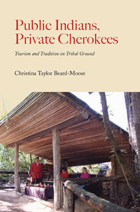 Public Indians, Private Cherokees: Tourism and Tradition on Tribal Ground
Christina Taylor Beard-Moose
University of Alabama Press, 2008 Explores the major economic industry among American Indian tribes—public promotion and display of aspects of their cultural heritage in a wide range of tourist venues
A major economic industry among American Indian tribes is the public promotion and display of aspects of their cultural heritage in a wide range of tourist venues. Few do it better than the Eastern Band of the Cherokee, whose homeland is the Qualla Boundary of North Carolina. Through extensive research into the work of other scholars dating back to the late 1800s, and interviews with a wide range of contemporary Cherokees, Beard-Moose presents the two faces of the Cherokee people. One is the public face that populates the powwows, dramatic presentations, museums, and myriad roadside craft locations. The other is the private face whose homecoming, Indian fairs, traditions, belief system, community strength, and cultural heritage are threatened by the very activities that put food on their tables. Constructing an ethnohistory of tourism and comparing the experiences of the Cherokee with the Florida Seminoles and Southwestern tribes, this work brings into sharp focus the fine line between promoting and selling Indian culture.
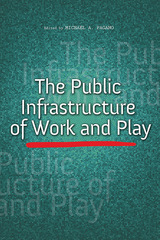 The Public Infrastructure of Work and Play
Michael A. Pagano
University of Illinois Press, 2018 A city's infrastructure influences the daily life of residents, neighborhoods, and businesses. But uniting the hard infrastructure of roads and bridges with the soft infrastructure of parks and public art creates significant political challenges. Planners at all stages must work at an intersection of public policy, markets, and aesthetics--while also accounting for how a project will work in both the present and the future. The latest volume in the Urban Agenda series looks at pressing infrastructure issues discussed at the 2017 UIC Urban Forum. Topics include: competing notions of the infrastructure ideal; what previous large infrastructure programs can teach the Trump Administration; how infrastructure influences city design; the architecture of the cities of tomorrow; who benefits from infrastructure improvements; and evaluations of projects like the Chicago Riverwalk and grassroots efforts to reclaim neighborhood parks from gangs. Contributors: Philip Ashton, Beverly S. Bunch, Bill Burton, Charles Hoch, Sean Lally, and Sanjeev Vidyarthi
 Public Intellectuals: A Study of Decline, With a New Preface and Epilogue
Richard A. Posner
Harvard University Press, 2001 In this timely book, the first comprehensive study of the modern American public intellectual--that individual who speaks to the public on issues of political or ideological moment--Richard Posner charts the decline of a venerable institution that included worthies from Socrates to John Dewey.
With the rapid growth of the media in recent years, highly visible forums for discussion have multiplied, while greater academic specialization has yielded a growing number of narrowly trained scholars. Posner tracks these two trends to their inevitable intersection: a proliferation of modern academics commenting on topics outside their ken. The resulting scene--one of off-the-cuff pronouncements, erroneous predictions, and ignorant policy proposals--compares poorly with the performance of earlier public intellectuals, largely nonacademics whose erudition and breadth of knowledge were well suited to public discourse.
Leveling a balanced attack on liberal and conservative pundits alike, Posner describes the styles and genres, constraints and incentives, of the activity of public intellectuals. He identifies a market for this activity--one with recognizable patterns and conventions but an absence of quality controls. And he offers modest proposals for improving the performance of this market--and the quality of public discussion in America today.
This paperback edition contains a new preface and and a new epilogue.
 Public Intellectuals in the Global Arena: Professors or Pundits?
Michael C. Desch
University of Notre Dame Press, 2016 What is a public intellectual? Where are they to be found? What accounts for the lament today that public intellectuals are either few in number or, worse, irrelevant? While there is a small literature on the role of public intellectuals, it is organized around various thinkers rather than focusing on different countries or the unique opportunities and challenges inherent in varied disciplines or professions. In Public Intellectuals in the Global Arena, Michael C. Desch has gathered a group of contributors to offer a timely and far-reaching reassessment of the role of public intellectuals in a variety of Western and non-Western settings. The contributors delineate the centrality of historical consciousness, philosophical self-understanding, and ethical imperatives for any intelligentsia who presume to speak the truth to power. The first section provides in-depth studies of the role of public intellectuals in a variety of countries or regions, including the United States, Latin America, China, and the Islamic world. The essays in the second section take up the question of why public intellectuals vary so widely across different disciplines. These chapters chronicle changes in the disciplines of philosophy and economics, changes that "have combined to dethrone the former and elevate the latter as the preeminent homes of public intellectuals in the academy." Also included are chapters that consider the evolving roles of the natural scientist, the former diplomat, and the blogger as public intellectuals. The final section provides concluding perspectives about the duties of public intellectuals in the twenty-first century.
"This is a first-rate contribution to the growing body of research on the phenomenon of public intellectuals. It clearly ranks high in a cohort of edited volumes that include Public Intellectuals: An Endangered Species? and The Public Intellectual and the Culture of Hope. Beyond appealing to public intellectuals, these essays are a rich interdisciplinary mix that will be of interest to scholars across a wide variety of fields in the social sciences and humanities." —Greg Russell, University of Oklahoma
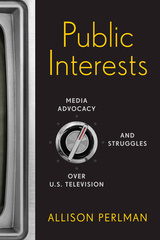 Public Interests: Media Advocacy and Struggles over U.S. Television
Perlman, Allison
Rutgers University Press, 2016 Winner of the 2017 Outstanding Book Award from the Popular Communication Division of the International Communication Association
Nearly as soon as television began to enter American homes in the late 1940s, social activists recognized that it was a powerful tool for shaping the nation’s views. By targeting broadcast regulations and laws, both liberal and conservative activist groups have sought to influence what America sees on the small screen. Public Interests describes the impressive battles that these media activists fought and charts how they tried to change the face of American television. Allison Perlman looks behind the scenes to track the strategies employed by several key groups of media reformers, from civil rights organizations like the NAACP to conservative groups like the Parents Television Council. While some of these campaigns were designed to improve the representation of certain marginalized groups in television programming, as Perlman reveals, they all strove for more systemic reforms, from early efforts to create educational channels to more recent attempts to preserve a space for Spanish-language broadcasting. Public Interests fills in a key piece of the history of American social reform movements, revealing pressure groups’ deep investments in influencing both television programming and broadcasting policy. Vividly illustrating the resilience, flexibility, and diversity of media activist campaigns from the 1950s onward, the book offers valuable lessons that can be applied to current battles over the airwaves.
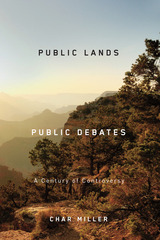 Public Lands, Public Debates: A Century of Controversy
Char Miller, editor
Oregon State University Press, 2012 The subject of historic struggle and contemporary dispute, public lands in the United States are treasured spaces. In Public Lands, Public Debates, environmental historian Char Miller explores the history of conservation thinking and the development of a government agency with stewardship at its mission. Owned in common, our national forests, monuments, parks, and preserves are funded through federal tax receipts, making these public lands national in scope and significance. Their controversial histories demonstrate their vulnerability to shifting tides of public opinion, alterations in fiscal support, and overlapping authorities for their management—including federal, state, and local mandates, as well as critical tribal prerogatives and military claims. Miller takes the Forest Service as a gauge of the broader debates in which Americans have engaged since the late nineteenth century. In nineteen essays,he examines critical moments of public and private negotiation to help explain the particular, and occasionally peculiar, tensions that have shaped the administration of public lands in the United States. “Watching democracy at work can be bewildering, even frustrating, but the only way individuals and organizations can sift through the often messy business of public deliberation is to deliberate...” —Char Miller, from the introduction
 Public Law, Private Practice: Politics, Profit, and the Legal Profession in Nineteenth-Century Japan
Darryl E. Flaherty
Harvard University Press, 2013 Long ignored by historians and repudiated in their time, practitioners of private law opened the way toward Japan’s legal modernity. From the seventeenth to the turn of the twentieth century, lawyers and their predecessors changed society in ways that first samurai and then the state could not. During the Edo period (1600–1868), they worked from the shadows to bend the shogun’s law to suit the market needs of merchants and the justice concerns of peasants. Over the course of the nineteenth century, legal practitioners changed law from a tool for rule into a new epistemology and laid the foundation for parliamentary politics during the Meiji era (1868–1912).
This social and political history argues that legal modernity sprouted from indigenous roots and helped delineate a budding nation’s public and private spheres. Tracing the transition of law regimes from Edo to Meiji, Darryl E. Flaherty shows how the legal profession emerged as a force for change in modern Japan and highlights its lasting contributions in founding private universities, political parties, and a national association of lawyers that contributed to legal reform during the twentieth century.
 Public Lettering: Script, Power, and Culture
Armando Petrucci
University of Chicago Press, 1993 Public lettering in all its forms—official inscriptions on
buildings, commercial graphics, signs, epitaphs on tombstones,
graffiti—is a fixture of urban life. In Public
Lettering, Armando Petrucci reconstructs the history of
public writing in the West and traces its social functions
from the eleventh century through the modern period.
Taking the city of Rome as a case study, Petrucci begins
with a consideration of the first civic inscriptions after
ancient times. Substantial chapters on the uses of public
writing in the industrial revolution and the early twentieth
century prepare the way for his provocative discussions of
public lettering in the the contexts of fascism, post-war
radicalism, and the student revolutions of 1968 and 1977.
Throughout, Petrucci is concerned with the relations
between the functions and styles of letters and the places
where they appear. Writing, he argues, is one of the
instruments of public power; display lettering is often the
image and mirror of power itself, making the social use of
written forms a type of conquest. Because of Rome's role as
a “World-City,” Petrucci's interdisciplinary study has
wide-ranging implications for our understanding of the social
function of graphic design.
Public Libraries in Nazi Germany
Margaret F. Stieg
University of Alabama Press, 1992 "Margaret F. Stieg's thoroughly researched study, the first comprehensive examination of public libraries in Nazi Germany, reveals that library policy in the Third Reich was far more complex than we might assume, with the positive and the negative hopelessly entangled. . . . A solid and welcome contribution."
—American Historical Review
 The Public Library Director's Toolkit
Kate Hall and Kathy Parker
American Library Association, 2019 New public library directors quickly learn what seasoned directors already know: running a library means you’ve always got your hands full—balancing the needs of staff, patrons, facilities, library boards, and other stakeholders with professional responsibilities like community interactions, legal and financial requirements, and whole lot else that wasn’t exactly in the job description. Whether you are considering becoming a public library director, are brand new to the role, or have settled in but find yourself thinking “there’s got to be a better way,” authors Hall and Parker are here to help. This book walks you through the core components of getting up to speed and then provides templates, sample documents, checklists, and other resources that will make your job easier. Gleaned from their own decades of experience in library leadership positions, in this toolkit they - cover such key topics as employees, trustees, finances, legal issues, library policies, emergency planning, and technology;
- discuss strategic planning and share advice on keeping up with trends;
- offer nearly two dozen ready-to-use resources, including a Director’s Report Template, a Social Media Policy, an Employee Exit Questionnaire, a Library Cleaning Checklist, a Vision Statement worksheet, and more; and
- suggest additional learning opportunities in each chapter to help you continue your learning journey.
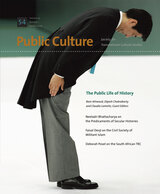 The Public Life of History, Volume 20
Bain Attwood, Dipesh Chakrabarty, and Claudio Lomnitz, eds.
Duke University Press This special issue of Public Culture explores the tension and the challenges raised by the interaction of history with the domains of public life, including politics, the law, and the media. It focuses specifically on situations where a social compact has been reshaped based on the revaluation of historical wounds such as those inflicted in South African apartheid and in the Holocaust. The politics of recognition has challenged historical research to serve public ends, invoking the past as the site of the original slight and calling for redress in the present. Gathering scholars involved in prominent debates regarding the shifting expectations of the rule of history, this special issue is a sustained engagement with historical experience, public discussion, and historical truth in a variety of global sites. One article considers what happens to the ideal of truth telling when truth commissions attempt to authenticate a complex mix of history and memory that is not always historically verifiable. Another article asks if history can continue to play an adjudicatory role in contemporary democracies when matters relating to the past are disputed in public life, as they are in India where the claims of scientific history are pitted against the culture-based history of Hindus. Still another contributor delves into the concept of “stolen generations” to explore the way indigenous people in Australia have laid claims in the present based on a historical wound. Contributors. Bain Attwood, Neeladri Bhattacharya, Dipesh Chakrabarty, George Chauncey, Miranda Johnson, Claudio Lomnitz, Deborah Posel
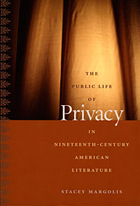 The Public Life of Privacy in Nineteenth-Century American Literature
Stacey Margolis
Duke University Press, 2005 Stacey Margolis rethinks a key chapter in American literary history, challenging the idea that nineteenth-century American culture was dominated by an ideology of privacy that defined subjects in terms of their intentions and desires. She reveals how writers from Nathaniel Hawthorne to Henry James depicted a world in which characters could only be understood—and, more importantly, could only understand themselves—through their public actions. She argues that the social issues that nineteenth-century novelists analyzed—including race, sexuality, the market, and the law—formed integral parts of a broader cultural shift toward understanding individuals not according to their feelings, desires, or intentions, but rather in light of the various inevitable traces they left on the world. Margolis provides readings of fiction by Hawthorne and James as well as Susan Warner, Mark Twain, Charles Chesnutt, and Pauline Hopkins. In these writers’ works, she traces a distinctive novelistic tradition that viewed social developments—such as changes in political partisanship and childhood education and the rise of new politico-legal forms like negligence law—as means for understanding how individuals were shaped by their interactions with society. The Public Life of Privacy in Nineteenth-Century American Literature adds a new level of complexity to understandings of nineteenth-century American culture by illuminating a literary tradition full of accidents, mistakes, and unintended consequences—one in which feelings and desires were often overshadowed by all that was external to the self.
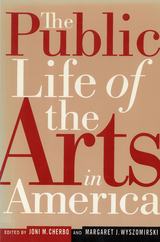 The Public Life of the Arts in America: The Public Life of the Arts in America, Revised Edition
Cherbo, Joni Maya
Rutgers University Press, 2000 Art and entertainment constitute America’s second-largest export. Most Americans—96%, to be exact—are somehow involved in the arts, whether as audience participants, hobbyists, or via broadcast, recording, video, or the Internet. The contribution of the arts to the U.S. economy is stunning: the nonprofit arts industry alone contributes over 857 billion dollars per year, and America’s fine and performing arts enjoy world-class status. Despite its size, quality, and economic impact, the arts community is not articulate about how they serve public interests, and few citizens have an appreciation of the myriad of public policies that influence American arts and culture. The contributors to this volume argue that U.S. policy can—and should—support the arts and that the arts, in turn serve a broad rather than an elite public. Indeed, increased support for the arts and culture equals good economic and trade policy; it also contributes to the quality of life and community, and helps sustain the creativity of American artists and organizations. By encouraging policy-makers to systematically start investigating the crucial role and importance of all of the arts in the United States, The Arts and Public Purpose moves the field forward with fresh ideas, new concepts, and important new data.
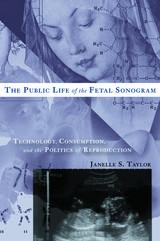 The Public Life of the Fetal Sonogram: Technology, Consumption, and the Politics of Reproduction
Taylor, Janelle S
Rutgers University Press, 2008 In The Public Life of the Fetal Sonogram, medical anthropologist Janelle S. Taylor analyzes the full sociocultural context of ultrasound technology and imagery. Drawing upon ethnographic research both within and beyond the medical setting, Taylor shows how ultrasound has entered into public consumer culture in the United States. The book documents and critically analyzes societal uses for ultrasound such as nondiagnostic "keepsake" ultrasound businesses that foster a new consumer market for these blurry, monochromatic images of eagerly awaited babies, and anti-abortion clinics that use ultrasound in an attempt to make women bond with the fetuses they carry, inciting a pro-life state of mind. This book offers much-needed critical awareness of the less easily recognized ways in which ultrasound technology is profoundly social and political in the United States today.
 Public Loves, Private Troubles: Migration, Technology, and Intimacy in Rural Indigenous Guatemala
Meghan Farley Webb
University of Alabama Press, 2025 Examines the role of digital technologies in the lives of Kaqchikel Maya women whose husbands work abroad. Anthropologist Meghan Farley Webb’s ethnography, Public Loves, Private Troubles, uses the lens of cellphones and other digital technologies to unpack marriage, love, sexuality, and family issues of Kaqchikel Maya women who remain in Guatemala while their husbands are part of the transnational migration workforce. Indigenous intimacy has been underexplored in ethnographic literature, and this is among the first books to focus on information technology's impact on intimacy and family in the Maya area. Overall, Webb shows how Maya women are empowered with their more autonomous lives when the husbands are absent but also are constrained by social media monitoring of their activities. To begin, Webb surveys the Tecpán highland setting and civil war and migration history. She discusses how neoliberal policies are manifested in the financial and emotional stress of having to leave for the United States for economic opportunities. Chapter 1 characterizes the lives of Maya women in Guatemala who “endure” while their husbands are working abroad. Webb describes how marriage, family, and even the Catholic Church shape how the women see themselves and their situations. Chapter 2 delves into the history and use of technologies, such as cellphones and WhatsApp, and how they affect communication in these transnational households. Insight is given to the family and personhood. Chapter 3 focuses on the prominent use of the Facebook platform. Men use the app to conduct extramarital affairs, but the app is also used by couples as a way to express a public performance of devotion and a happy family. Chapter 4 focuses on the surveillance, including malicious gossip, that Kaqchikel women are subjected to especially from their mothers-in-law, who live nearby or in the same household. The narrative culminates in a discussion of how many wives are happier and more empowered without the men at home, yet they still can experience uncertainty, loneliness, and depression.
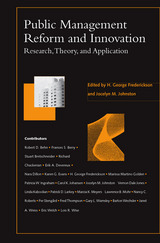 Public Management Reform and Innovation: Research, Theory, and Application
H. George Frederickson
University of Alabama Press, 1999 Leading scholars present the most complete, as well as the most advanced, treatment of public management reform and innovation available The subject of reform in the public sector is not new; indeed, its latest rubric, reinventing government, has become good politics. Still, as the contributors ask in this volume, is good politics necessarily good government? Given the growing desire to reinvent government, there are hard questions to be asked: Is the private sector market model suitable and effective when applied to reforming public and governmental organizations? What are the major political forces affecting reform efforts in public management? How is public management reform accomplished in a constitutional democratic government? How do the values of responsiveness, professionalism, and managerial excellence shape current public management reforms? In this volume, editors H. George Frederickson and Jocelyn M. Johnston bring together scholars with a shared interest in empirical research to confront head-on the toughest questions public managers face in their efforts to meet the demands of reform and innovation. Throughout the book, the authors consider the bureaucratic resistance that results when downsizing and reinvention are undertaken simultaneously, the dilemma public managers face when elected executives set a reform agenda that runs counter to the law, and the mistaken belief that improved management can remedy flawed policy.
 Public Memory in Early China
K. E. Brashier
Harvard University Press, 2014 In early imperial China, the dead were remembered by stereotyping them, by relating them to the existing public memory and not by vaunting what made each person individually distinct and extraordinary in his or her lifetime. Their posthumous names were chosen from a limited predetermined pool; their descriptors were derived from set phrases in the classical tradition; and their identities were explicitly categorized as being like this cultural hero or that sage official in antiquity. In other words, postmortem remembrance was a process of pouring new ancestors into prefabricated molds or stamping them with rigid cookie cutters. Public Memory in Early China is an examination of this pouring and stamping process. After surveying ways in which learning in the early imperial period relied upon memorization and recitation, K. E. Brashier treats three definitive parameters of identity—name, age, and kinship—as ways of negotiating a person’s relative position within the collective consciousness. He then examines both the tangible and intangible media responsible for keeping that defined identity welded into the infrastructure of Han public memory.
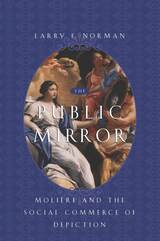 The Public Mirror: Moliere and the Social Commerce of Depiction
Larry F. Norman
University of Chicago Press, 1999 Though much beloved and widely produced, Molière's satirical comedies pose a problem for those reading or staging his works today: how can a genre associated with biting caricature and castigation deliver engaging theater? Instead of simply dismissing social satire as a foundation for Molière's theater, as many have done, Larry F. Norman takes seriously Molière's claim that his satires are first and foremost effective theater.
Pairing close readings of Molière's comedies with insightful accounts of French social history and aesthetics, Norman shows how Molière conceived of satire as a "public mirror" provoking dynamic exchange and conflict with audience members obsessed with their own images. Drawing on these tensions, Molière portrays characters satirizing one another on stage, with their reactions providing dramatic conflict and propelling comic dialogue. By laying bare his society's system of imagining itself, Molière's satires both enthralled and enraged his original audience and provide us with a crucial key to the classical culture of representation.
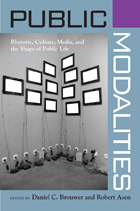 Public Modalities
Edited by Daniel C. Brouwer and Robert Asen
University of Alabama Press, 2010 A bold rethinking of public discourse, Public Modalities explores how people shape civic life through protest, media, and identity in an ever-evolving public sphere.
This book explores the ways that scholars, journalists, politicians, and citizens conceive of “the public” or “public life,” and how those entities are defined and invented. For decades, scholars have used the metaphors of spheres, systems, webs, or networks to talk about, describe, and map various practices. This volume proposes a new metaphor—modalities—to suggest that publics are forever in flux, and much more fluid and dynamic than the static models of systems or spheres would indicate—especially in the digital age, where various publics rapidly evolve and dissipate.
Contributors to the volume—employing approaches from the fields of communication studies, English, sociology, psychology, and history—explore a broad range of texts and artifacts that give rise to publics, and discuss what they reveal about conceptualizations of social space. By focusing on process in public engagement, these scholars highlight questions of how people advance their interests and identities, and how they adapt to situational constraints.
Bringing together scholars in rhetorical, cultural, and media studies, this collection of new case studies illustrates a modalities approach to the study of publics. These case studies explore the implications of different ways of forming publics, including alternative means of expression (protests, culture jamming); the intersection of politics and consumerism (how people express their identities and interests through their consumer behavior); and online engagement (blogs as increasingly important public fora). In doing so, they raise important questions of access, community, and political efficacy
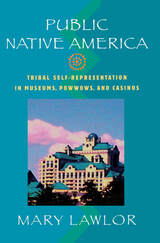 Public Native America: Tribal Self-Representations in Museums, Powwows, and Casinos
Lawlor, Mary
Rutgers University Press, 2006 The Native American casino and gaming industry has attracted unprecedented American public attention to life on reservations. Other tribal public venues, such as museums and powwows, have also gained in popularity among non-Native audiences and become sites of education and performance. In PublicNative America, Mary Lawlor explores the process of tribal self-definition that the communities in her study make available to off-reservation audiences. Focusing on architectural and interior designs as well as performance styles, she reveals how a complex and often surprising cultural dynamic is created when Native Americans create lavish displays for the public’s participation and consumption. Drawing on postcolonial and cultural studies, Lawlor argues that these venues serve as a stage where indigenous communities play out delicate negotiations—on the one hand retaining traditional beliefs and rituals, while on the other, using what they have learned about U.S. politics, corporate culture, tourism, and public relations to advance their economic positions.
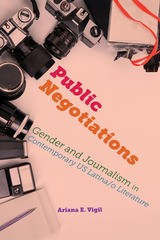 Public Negotiations: Gender and Journalism in Contemporary US Latina/o Literature
Ariana E. Vigil
Ohio State University Press, 2019 Ariana E. Vigil’s interdisciplinary study, Public Negotiations: Gender and Journalism in Contemporary US Latina/o Literature examines how the boundaries of the Latina/o public sphere are negotiated through mass media. : Focusing on a wide range of twentieth- and twenty-first-century Latina/o literary texts that feature Latina/o media figures—works by Lucha Corpi, Oscar Zeta Acosta, Cherríe Moraga, and Rubén Salazar, among others—Vigil examines the relationship between Latina/o media and Latina/o publics and reflects on how literature demonstrates a sustained interest in this relationship.
Vigil also reveals how these conversations inevitably engage with gender concerns, showing how the role of gender in this relationship is neither static nor consistent over time. Examining how these works represent such things as gendered Latina/o counter publics, how Central American–American communities are gendered in relation to other US Latina/o communities, how and why gendered expressions of Latinidad are produced and marketed, and how print media provides an important space for dissemination of diverse ideas, Public Negotiations considers the way in which gender functions in terms of both the construction and reception of a Latina/o public in a transnational space. Through thorough examination and with deep insight, Vigil shows how literature can invaluably reflect current and historical issues surrounding media and the public sphere and help us imagine new, hopefully better, possibilities.
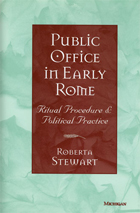 Public Office in Early Rome: Ritual Procedure and Political Practice
Roberta Stewart
University of Michigan Press, 2010 ". . . [A]n excellent, erudite book."
---Bryn Mawr Classical Review Studies of Roman politics have traditionally emphasized individual personalities or groups of personalities and have explained political behavior in terms of contests for individual power or group power. By contrast, Roberta Stewart focuses on being the religious institution of the "allotment" of duties among elected officials as a primary control on Roman politics. She examines in detail the procedure of allotment, the roles of popular election and allotment in defining public authority and duty, and the relationship between the Roman Senate and elected officials. Allotment is seen to reflect Republican ideology about the divine sanction of Roman leadership, military enterprise, and empire.
Allotment is examined in particular historical contexts, and the successive formations of public office in 444, 367, and 242 b.c.e. are analyzed as a series of political solutions in an evolving cultural context. The discussion documents the ritual definition of allotments and the historical development of distinctive features of Republican political office: the equal authority of colleagues (collegiality), the individual authority and accountability for an allotted function (provincia), the procedural alternative to allotment (comparatio), and the hierarchy of offices with imperium (the consuls and praetors).
Public Office in Early Rome will be of great interest for scholars and students of Roman religion, government, and history.
Roberta Stewart is Associate Professor of Classics, Dartmouth College.
 Public Opinion and American Foreign Policy, Revised Edition
Ole R. Holsti
University of Michigan Press, 2004
Thoroughly revised edition of an essential text, incorporating a wealth of new material on American foreign policy since 9/11.
The second edition of this concise masterwork includes vast amounts of new material on American foreign policy in the post-9/11 era, including the war in Iraq. Holsti explores the poorly understood role of public opinion in international affairs, looking at Americans' capacity to make informed judgments about issues far removed from their personal experience.
"Impressively comprehensive and current: an excellent revision of a book by the #1 authority on the topic. This new edition will remain at the forefront for consultation and textbook adoption on the topic for years to come."
-Bruce Russett, Yale University
"I thought the first edition was the best single treatment of the subject-so, apparently, did the student who 'borrowed' my copy-and this is a worthy successor. The new edition almost flawlessly accomplishes the goal Holsti sets for himself: an update of his landmark book in light of emerging research and the dramatically changed state of the world that confronts U.S. foreign policy."
-Randy Siverson, University of California, Davis
"For those who are curious about the impact of 9/11 on American public opinion, for serious students of the relationship between foreign policy and public opinion, for anyone who wants to understand contemporary American opinion about the United States' place in the world, and for citizens tired of conventional wisdom about a difficult and important subject, Holsti's study is not only interesting and topical, it is essential."
-Maxine Isaacs, Kennedy School of Government, Harvard University
"In an age of almost weekly polling on foreign policy, Holsti's insights are indispensable. He delivers double tour de force in this new edition, providing his own current and historical research along with a comprehensive synthesis of the existing literature. His analysis of the relationships between public opinion and foreign policy since 9/11 will prove particularly valuable for students and scholars alike."
-Richard Eichenberg, Tufts University
"Holsti combines a vast knowledge of political history and a mastery of the relevant scholarship with up-to-date empirical data to address the question of what role the general public can play in shaping foreign policy. This revised edition is a remarkable achievement."
-Shoon Murray, School of International Service, American University
 Public Opinion and the Political Future of the Nation's Capital
Edward M. Meyers
Georgetown University Press, 1996 Despite widespread agreement that the District of Columbia's political system has collapsed, there is a serious lack of thoughtful proposals addressing the political future of the nation's capital. In this book, Edward M. Meyers examines the opinions of average Americans about Washington, D.C., in order to understand how many Americans are likely to approach the question of what reforms are needed. Meyers first explores the political, economic, and social conditions of the District, providing an informed context for understanding and evaluating its political options. Presenting the results of in-depth qualitative research with focus groups held across the country, Meyers reveals that regardless of the participants' knowledge about the District, their beliefs in six basic concepts or schemata—such as respect for democratic rights, attitudes about race, and aversion to an intrusive federal government—molded their opinions about various options for District self-governance.
The book concludes with insights into the District by local and national political leaders, including OMB Director Alice Rivlin, Jesse Jackson, Representatives Eleanor Holmes Norton, Thomas Davis, and James Walsh, and Marion Barry.
Public Opinion Polling: A Handbook For Public Interest And Citizen Advocacy Groups
Celinda Lake; Montana Alliance for Progressive Policy
Island Press, 1987 In Public Opinion Polling, Celinda C. Lake and Pat Callbeck Harper draw on years of experience and hands-on work in polling and interpreting public opinion polls for political candidates and public interest organizations. This handbook offers field-tested, easy-to-use, and cost-effective instructions for constructing and analyzing polls. Helps the user to: define the poll's objectives understand what a sample is write questionnaires that get the information you want conduct efficient interviews. Companion software provides a complete package for conducting polls and analyzing results.
 Public Opinion, Propaganda, and Politics in 18th-Century England: A Study of the Jew Bill of 1753
Thomas W. Perry
Harvard University Press In 1753, at the request of the London Jewish community, the Peiham administration passed an act repealing the religious test that prevented Jewish aliens from being naturalized. This act, formally known as the Jewish Naturalization Act, was of negligible practical importance, but political opponents exploited the issue for an upcoming election campaign. The "Jew Bill" became a battle cry that swept across England. The Peiham administration, sensing the political damage that could be caused by the bill, bowed to the clamor and then took the initiative in defeating its own act.
This book is the first thorough account of that notorious but little-understood episode in English history. Using a largely narrative form the author first discusses the position of the Jews in the mid-eighteenth century and explains why they sought and obtained passage of the bill. He then recounts the beginnings of opposition to it and discusses the religious, economic, political, and psychological reasons for the opposition. He describes in detail the propaganda campaign against the bill and the resultant effect on the election.
The author concludes that this was not an isolated explosion of anti-Semitism, but rather a renewal of a long-standing debate over general naturalization policy. He further concludes that Parliament was more sensitive to public opinion than is generally supposed and that the terms "Whig supremacy" or "trusteeship" are not entirely accurate.
The reader will find that this study reveals much of the English political system of that era: the style and structure of parliamentary politics and electioneering; religious attitudes and economic notions; and the methods and ethical and intellectual standards of journalism and political propaganda.
 The Public Option: How to Expand Freedom, Increase Opportunity, and Promote Equality
Ganesh Sitaraman and Anne L. Alstott
Harvard University Press, 2019 A solution to inequalities wherever we look—in health care, secure retirement, education—is as close as the public library. Or the post office, community pool, or local elementary school. Public options—reasonably priced government-provided services that coexist with private options—are all around us, ready to increase opportunity, expand freedom, and reawaken civic engagement if we will only let them.
Whenever you go to your local public library, send mail via the post office, or visit Yosemite, you are taking advantage of a longstanding American tradition: the public option. Some of the most useful and beloved institutions in American life are public options—yet they are seldom celebrated as such. These government-supported opportunities coexist peaceably alongside private options, ensuring equal access and expanding opportunity for all.
Ganesh Sitaraman and Anne Alstott challenge decades of received wisdom about the proper role of government and consider the vast improvements that could come from the expansion of public options. Far from illustrating the impossibility of effective government services, as their critics claim, public options hold the potential to transform American civic life, offering a wealth of solutions to seemingly intractable problems, from housing shortages to the escalating cost of health care.
Imagine a low-cost, high-quality public option for child care. Or an extension of the excellent Thrift Savings Plan for federal employees to all Americans. Or every person having access to an account at the Federal Reserve Bank, with no fees and no minimums. From broadband internet to higher education, The Public Option reveals smart new ways to meet pressing public needs while spurring healthy competition. More effective than vouchers or tax credits, public options could offer us all fairer choices and greater security.
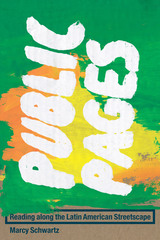 Public Pages: Reading Along the Latin American Streetscape
By Marcy Schwartz
University of Texas Press, 2018 Public reading programs are flourishing in many Latin American cities in the new millennium. They defy the conception of reading as solitary and private by literally taking literature to the streets to create new communities of readers. From institutional and official to informal and spontaneous, the reading programs all use public space, distribute creative writing to a mass public, foster collective rather than individual reading, and provide access to literature in unconventional arenas. The first international study of contemporary print culture in the Americas, Public Pages reveals how recent cultural policy and collective literary reading intervene in public space to promote social integration in cities in Colombia, Argentina, Brazil, Mexico, and Chile. Marcy Schwartz looks at broad institutional programs such as UNESCO World Book Capital campaigns and the distribution of free books on public transportation, as well as local initiatives that produce handmade books out of recycled materials (known as cartoneras) and display banned books at former military detention centers. She maps the connection between literary reading and the development of cultural citizenship in Latin America, with municipalities, cultural centers, and groups of ordinary citizens harnessing reading as an activity both social and literary. Along with other strategies for reclaiming democracy after decades of authoritarian regimes and political violence, as well as responding to neoliberal economic policies, these acts of reading collectively in public settings invite civic participation and affirm local belonging.
 The Public Papers
Louis Sullivan
University of Chicago Press, 1988 This volume brings together for the first time all the papers Louis Sullivan intended for a public audience, from his first interview in 1882 to his last essay in 1924. Organized chronologically, these speeches, interviews, essays, letters to editors, and committee reports enable readers to trace Sullivan's development from a brash young assistant to Dankmar Adler to an architectural elder statesman. Robert Twombly, an authority on Sullivan's work and life, has introduced each document with a headnote explaining its significance, locating it in time and place, and examining its immediate context. He has also provided a general introduction that analyzes Sullivan's writing style and objectives, his major philosophical themes, and the sources of his ideas. With the help of headnotes and introduction, readers will get a thorough sense of Sullivan's concerns, discover how his ideas evolved and changed, and appreciate the circumstances under which new interests emerged.
This collection is a handy introduction to the full range of Sullivan's thinking, the book with which readers interested in the architect's writings should begin. As a companion volume to Robert Twombly's biography of Sullivan, it gives a comprehensive picture of one of America's most important architects and cultural figures.
Public Perceptions of Artificial Intelligence for Homeland Security
Benjamin Boudreaux
RAND Corporation, 2024 To evaluate public perception of the benefits and risks of U.S. Department of Homeland Security use of artificial intelligence technologies, researchers surveyed the nationally representative RAND American Life Panel about the department’s uses of these technologies, with a focus on four types of technologies: facial recognition technology, license plate–reader technology, risk-assessment technology, and mobile phone location data.
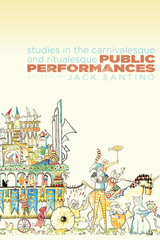 Public Performances: Studies in the Carnivalesque and Ritualesque
Jack Santino
Utah State University Press, 2024 Public Performances offers a deep and wide-ranging exploration of relationships among genres of public performance and of the underlying political motivations they share. Illustrating the connections among three themes—the political, the carnivalesque, and the ritualesque—this volume provides rich and comprehensive insight into public performance as an assertion of political power. Contributors consider how public genres of performance express not only celebration but also dissent, grief, and remembrance; examine the permeability of the boundaries between genres; and analyze the approval or regulation of such events by municipalities and other institutions. Where the particular use of public space is not sanctioned or where that use meets with hostility from institutions or represents a critique of them, performers are effectively reclaiming public space to make public statements on their own terms—an act of popular sovereignty. Through these concepts, Public Performances distinguishes the sometimes overlapping dimensions of public symbolic display. Carnival, and thus the carnivalesque, is understood to possess tacit social permission for unconventional or even deviant performance, on the grounds that normal social order will resume when the performance concludes. Ritual, and the ritualesque, leverages a deeper symbolic sensibility, one believed—or at least intended—by the participants to effect transformative, longer-term change. Contributors: Roger D. Abrahams, John Borgonovo, Laurent Sébastien Fournier, Lisa Gilman, Barbara Graham, David Harnish, Samuel Kinser, Scott Magelssen, Elena Martinez, Pamela Moro, Beverly J. Stoeltje, Daniel Wojcik, Dorothy L. Zinn
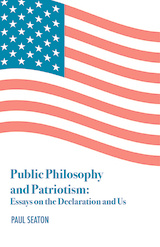 Public Philosophy and Patriotism: Essays on the Declaration and Us
Paul Seaton
St. Augustine's Press, 2024 Paul Seaton’s Public Philosophy and Patriotism: The Declaration and Us is a very countercultural book. It advances the provocative thesis that not only is the Declaration worthy of our study today, but its principles and way of thinking about politics can and should be used to judge us and our politics today. That’s countercultural. While conservatives still have a warm place for the document in their hearts, one rarely hears them apply it to today’s debates. Progressives tend to take two contradictory tacks toward the founding document: on one hand, it’s the negligible product of hypocritical white males, on another, it limns the “ideals” and “values” of the American project that History is charged with fulfilling. Neither of these views takes the document intellectually seriously. Jefferson, however, articulated a different view when he called the Declaration “an expression of the American mind” at the time of the Revolution. Here was a self-conscious, self-confident American mind, ready to take on the world. Taking his cue from Jefferson, Seaton takes the Declaration seriously. He takes it seriously as the expression of a mind that confidently judged despotic designs, but also grasped the principles of free government and free and reasonable politics and looked forward to a country embodying them. Seaton argues that both these dimensions of Declaration political thought are applicable today.
He does so in an interesting way. For a number of years, he penned a Fourth of July essay on “the Declaration and Us” for the Law & Liberty website. On that occasion, he provided an exposition of some theme of the Declaration and applied it to a contemporary debate or issue. Over the years, they added up to a rather full exposition of the document, as well as an ongoing commentary on American political life. With this collection, the essentials of the Declaration’s view of politics are laid bare, and significant threats to freedom-loving Americans are identified. This is the bold claim and aim of this unique book.
At the beginning and end of the collection, Seaton makes a point of dating the completion of the manuscript on April 18th. When the curious reader looks up the date, he finds that it is the date when Paul Revere undertook his famous ride. In this way, the author indicates his judgment of the dire circumstances in which we live today and the patriotic models to which he hearkens. In the form of an explication de texte, this collection is a call to arms against today’s enemies of ordered liberty.
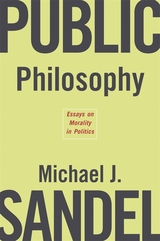 Public Philosophy: Essays on Morality in Politics
Michael J. Sandel
Harvard University Press, 2006 In this book, Michael Sandel takes up some of the hotly contested moral and political issues of our time, including affirmative action, assisted suicide, abortion, gay rights, stem cell research, the meaning of toleration and civility, the gap between rich and poor, the role of markets, and the place of religion in public life. He argues that the most prominent ideals in our political life--individual rights and freedom of choice--do not by themselves provide an adequate ethic for a democratic society. Sandel calls for a politics that gives greater emphasis to citizenship, community, and civic virtue, and that grapples more directly with questions of the good life. Liberals often worry that inviting moral and religious argument into the public sphere runs the risk of intolerance and coercion. These essays respond to that concern by showing that substantive moral discourse is not at odds with progressive public purposes, and that a pluralist society need not shrink from engaging the moral and religious convictions that its citizens bring to public life.
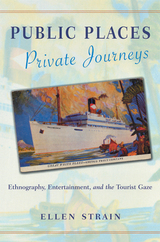 Public Places, Private Journeys: Ethnography, Entertainment, and the Tourist Gaze
Strain, Ellen
Rutgers University Press, 2003 In this globally interconnected planet, we are increasingly able to access exotic locales without ever actually seeing these places firsthand. Instead, what we perceive to be fresh cultural experiences are actually second-hand moments, filtered through mediums such as television, film, the internet, CD-Roms, and various other media.
Ellen Strain posits that the images in film and popular culture not only fill in the gaps of a person’s first-hand—or rather, lack of first-hand—experience with other cultural situations, but also predisposes the “tourist gaze” to view particular locales in a predetermined way. She theorizes the idea of a touristic way of understanding the world in general. How, she asks, are our cross-cultural perceptions of places and peoples created in the first place? Can a set of images—such as postcards—mediate our vision of distant geographies? Are there culturally constructed strategies set up to mediate our cross-cultural perceptions of the exotic? Strain includes the works of Jules Verne, E. M. Forster, and Michael Crichton, as well as film, CD-Rom travel games and virtual reality in her own authorial gaze.
Public Places, Private Journeys is a unique postmodern exploration of how individuals see across cultural differences in an era of increasingly commercialized and globalized culture.
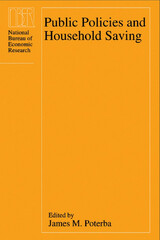 Public Policies and Household Saving
Edited by James M. Poterba
University of Chicago Press, 1994 The declining U.S. national saving rate has prompted economists and policymakers to ask, should the federal government encourage household saving, and if so, through which policies? In order to better understand saving programs, this volume provides a systematic and detailed description of saving policies in the G-7 industrialized nations: the United States, Canada, France, Germany, Italy, Japan, and the United Kingdom.
Each of the seven chapters focuses on one country and addresses a core set of topics: types of accumulated household savings and debt; tax policies toward capital income; saving in the form of public and private pensions, including Social Security and similar programs; saving programs that receive special tax treatment; and saving through insurance.
This detailed summary of the saving incentives of the G-7 nations will be an invaluable reference for policymakers and academics interested in personal saving behavior.
Public Policy: A Comprehensive Introduction
Martin Potucek
Karolinum Press, 2017 This book provides an up-to-date, comprehensive, synoptic, and easy-to-grasp account of the state of public policy as a field. Both a scholar and a Czech policy maker, Martin Potůček draws on his vast and diverse experience to offer descriptions of public policy’s normative and conceptual foundations, stages, actors, and institutions, as well as fifteen of the most frequently used public policy theories. Featuring illustrative empirical case studies, this innovative guide shows how these theories can be applied to making public policy. With particular insight into the importance of cultural context and historical legacies for policy making in post-Communist Europe, Public Policy provides nuanced, expert insight into the difficulties of public policy discourse and reform.
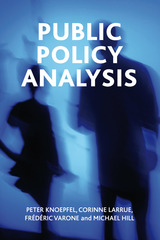 Public Policy Analysis
Peter Knoepfel, Corinne Larrue, Frédéric Varone, and Michael Hill
Bristol University Press, 2011 This book is an English version of a successful text* on public policy analysis originally written for policy practitioners in Switzerland and France. It presents a model for the analysis of public policy and includes examples of its application in everyday political-administrative situations. This English version introduces supplementary illustrations and examples from the United Kingdom. Structured and written accessibly for readers who may not have an academic background in the social sciences, Public Policy Analysis applies key ideas from sociology, political science, administrative science and law to develop an analytical framework that can be used to carry out empirical studies on different public policies.British scholars, practitioners and students are introduced all too rarely to ideas from the Francophone world, and this book will contribute to remedying that. It will be particularly relevant for students and practitioners of public administration.
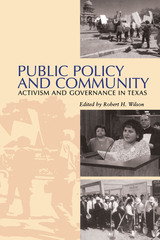 Public Policy and Community: Activism and Governance in Texas
Edited by Robert H. Wilson
University of Texas Press, 1997 The decentralization of public policy from the federal government to state and local governments offers increased opportunities for ordinary citizens to participate directly in public policymaking. Yet these opportunities may not be equally shared. Due to a variety of factors, low-income citizens have long been denied a meaningful role in the public life and governance of our country. By contrast, the essays in this volume explore how low-income citizens have successfully affected public policy. The book is built around six case studies, all from Texas, that cover education finance and reform, local infrastructure provision, environmental protection, and indigent health care. This research illuminates several issues of national importance, including how communities gain standing and recognition for themselves and their issues, how policy agendas are defined, how communities mobilize technical and institutional resources, and how they form coalitions and alliances to accomplish their goals.
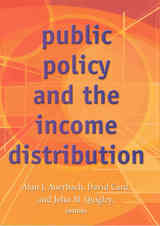 Public Policy and the Income Distribution
Alan J. Auerbach
Russell Sage Foundation, 2006 Over the last forty years, rising national income has helped reduce poverty rates, but this has been accompanied by an increase in economic inequality. While these trends are largely attributed to technological change and demographic shifts, such as changing birth rates, labor force patterns, and immigration, public policies have also exerted a profound affect on the welfare of Americans. In Public Policy and the Income Distribution, editors Alan Auerbach, David Card, and John Quigley assemble a distinguished roster of policy analysts to confront the key questions about the role of government policy in altering the level and distribution of economic well being. Public Policy and the Income Distribution tackles many of the most difficult and intriguing questions about how government intervention—or lack thereof—has affected the incomes of everyday Americans. Rebecca Blank analyzes welfare reform, and presents systematic research on income, poverty rates, and welfare and labor force participation of single mothers. She finds that single mothers worked more and were less dependent on public assistance following welfare reform, and that low-skilled single mothers had no greater difficulty finding work than others. Timothy Smeeding compares poverty reduction programs in the United States with policies in other developed countries. Poverty and inequality are higher in the United States than in other advanced economies, but Smeeding argues that this is largely a result of policy choices. Poverty rates based on market incomes alone are actually lower in the United States than elsewhere, but government interventions in the United States were less than half as effective at reducing poverty as were programs in the other countries. The most dramatic poverty reduction story of twentieth century America was seen among the elderly, who went from being the age group most likely to live in poverty in the 1960s to the group least likely to be poor at the end of the century. Gary Englehardt and Jonathan Gruber examine the role of policy in alleviating old-age poverty by estimating the impact of Social Security benefits on the income of the elderly poor. They find that the growth in Social Security almost completely explains the large decline in elderly poverty in the United States The twentieth century was remarkable in the extent to which advances in public policy helped improve the economic well being of Americans. Synthesizing existing knowledge on the effectiveness of public policy and contributing valuable new research, Public Policy and the Income Distribution examines public policy's successes, and points out the areas in which progress remains to be made.
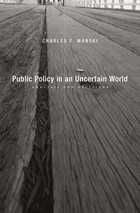 Public Policy in an Uncertain World: Analysis and Decisions
Charles F. Manski
Harvard University Press, 2013 Public policy advocates routinely assert that “research has shown” a particular policy to be desirable. But how reliable is the analysis in the research they invoke? And how does that analysis affect the way policy is made, on issues ranging from vaccination to minimum wage to FDA drug approval? Charles Manski argues here that current policy is based on untrustworthy analysis. By failing to account for uncertainty in an unpredictable world, policy analysis misleads policy makers with expressions of certitude. Public Policy in an Uncertain World critiques the status quo and offers an innovation to improve how policy research is conducted and how policy makers use research.
Consumers of policy analysis, whether civil servants, journalists, or concerned citizens, need to understand research methodology well enough to properly assess reported findings. In the current model, policy researchers base their predictions on strong assumptions. But as Manski demonstrates, strong assumptions lead to less credible predictions than weaker ones. His alternative approach takes account of uncertainty and thereby moves policy analysis away from incredible certitude and toward honest portrayal of partial knowledge. Manski describes analysis of research on such topics as the effect of the death penalty on homicide, of unemployment insurance on job-seeking, and of preschooling on high school graduation. And he uses other real-world scenarios to illustrate the course he recommends, in which policy makers form reasonable decisions based on partial knowledge of outcomes, and journalists evaluate research claims more closely, with a skeptical eye toward expressions of certitude.
Public Policy in Latin America: A Comparative Survey
John W. Sloan
University of Pittsburgh Press, 1984
The study of Latin America has long been an ideological battleground. Scholars disagree on every major issue: the impact of the U.S. influence in the region, the political orientation of the middle class, the role of the military, the rate of socioeconomic change, and the viability of reform.
Public Policy in Latin America is a masterful synthesis of scholarship on the region. Sloan studies political phenomena not by making superficial comparisons between leaders, parties or styles, but by examining what governments do-the creation of public policy through political process. The decisions to stress accumulation versus distribution of economic goods, the role of the bureaucracy, and the quality of political participation tell more about a nation than what party or persons are in power.
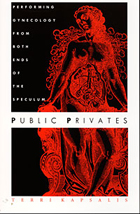 Public Privates: Performing Gynecology from Both Ends of the Speculum
Terri Kapsalis
Duke University Press, 1997 In Public Privates, a book about looking and being looked at, about speculums, spectacles, and spectators, about display, illumination, and reflection, Terri Kapsalis makes visible the practices and representations of gynecology. The quintessential examination of women, gynecology is not simply the study of women’s bodies, but also serves to define and constitute them. Any critical analysis of gynecology is therefore, as Kapsalis affirms, an investigation of what it means to be female. In this respect she considers the public exposure of female "privates" in the performance of the pelvic exam.
From J. Marion Sims’s surgical experiments on unanesthetized slave women in the mid-nineteenth century, to the use of cadavers and prostitutes to teach medical students gynecological techniques, Kapsalis focuses on the ways in which women and their bodies have been treated by the medical establishment. Removing gynecology from its private cover within clinic walls and medical textbook pages, she decodes the gynecological exam, seizing on its performative dimension. She considers traditional medical practices and the dynamics of "proper" patient performance; non-traditional practices such as cervical self-exam; and incarnations of the pelvic examination outside the bounds of medicine, including its appearance in David Cronenberg’s film Dead Ringers and Annie Sprinkle’s performance piece "Public Cervix Announcement."
Confounding the boundaries that separate medicine, art, and pornography, revealing the potent cultural attitudes and anxieties about women, female bodies, and female sexuality that permeate the practice of gynecology, Public Privates concludes by locating a venue from which challenging, alternative performances may be staged.
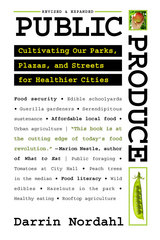 Public Produce: Cultivating Our Parks, Plazas, and Streets for Healthier Cities
Darrin Nordahl
Island Press, 2015 Plum and pear trees shade park benches in Kamloops, British Columbia. Tomatoes and cucumbers burst forth from planters at City Hall in Provo, Utah. Strawberries and carrots flourish along the sunny sidewalks of a Los Angeles neighborhood.
The idea that public land could be used creatively to grow fresh food for local citizens was beginning to gain traction when Public Produce was first published in 2009, but there were few concrete examples of action. Today, things are different: fruits and vegetables are thriving in parks, plazas, along our streets, and around our civic buildings.
This revised edition of Public Produce profiles the many communities and community officials that are rethinking the role of public space in cities, and shows how places as diverse as parking lots and playgrounds can sustain health and happiness through fresh produce. But these efforts produce more than food. Revitalizing urban areas, connecting residents with their neighborhoods, and promoting healthier lifestyles are just a few of the community goods we harvest from growing fruits and vegetables in our public gathering spots.
Taking readers from inspiration to implementation, Public Produce is chock full of tantalizing images and hearty lessons for bringing agriculture back into our cities.
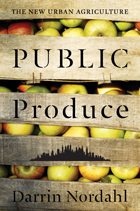 Public Produce: The New Urban Agriculture
Darrin Nordahl
Island Press, 2009 Public Produce makes a uniquely contemporary case not for central government intervention, but for local government involvement in shaping food policy. In what Darrin Nordahl calls “municipal agriculture,” elected officials, municipal planners, local policymakers, and public space designers are turning to the abundance of land under public control (parks, plazas, streets, city squares, parking lots, as well as the grounds around libraries, schools, government offices, and even jails) to grow food.
Public agencies at one time were at best indifferent about, or at worst dismissive of, food production in the city. Today, public officials recognize that food insecurity is affecting everyone, not just the inner-city poor, and that policies seeking to restructure the production and distribution of food to the tens of millions of people living in cities have immediate benefits to community-wide health and prosperity.
This book profiles urban food growing efforts, illustrating that there is both a need and a desire to supplement our existing food production methods outside the city with opportunities inside the city. Each of these efforts works in concert to make fresh produce more available to the public. But each does more too: reinforcing a sense of place and building community; nourishing the needy and providing economic assistance to entrepreneurs; promoting food literacy and good health; and allowing for “serendipitous sustenance.” There is much to be gained, Nordahl writes, in adding a bit of agrarianism into our urbanism.
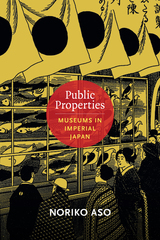 Public Properties: Museums in Imperial Japan
Noriko Aso
Duke University Press, 2013 In the late nineteenth century, Japan's new Meiji government established museums to showcase a national aesthetic heritage. Inspired by Western museums and expositions, these institutions were introduced by government officials hoping to spur industrialization and self-disciplined public behavior, and to cultivate an "imperial public" loyal to the emperor. Japan's network of museums expanded along with its colonies. By the mid-1930s, the Japanese museum system had established or absorbed institutions in Taiwan, Korea, Sakhalin, and Manchuria. Not surprising, colonial subjects' views of Japanese imperialism differed from those promulgated by the Japanese state. Meanwhile, in Japan, philanthropic and commercial museums were expanding, revising, and even questioning the state-sanctioned aesthetic canon. Public Properties describes how museums in Japan and its empire contributed to the reimagining of state and society during the imperial era, despite vigorous disagreements about what was to be displayed, how, and by whom it was to be seen.
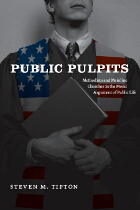 Public Pulpits: Methodists and Mainline Churches in the Moral Argument of Public Life
Steven M. Tipton
University of Chicago Press, 2008 Since the 2000 presidential election, debate over the role of religion in public life has followed a narrow course as pundits and politicians alike have focused on the influence wielded by conservative Christians. But what about more mainstream Christians? Here, Steven M. Tipton examines the political activities of Methodists and mainline churches in this groundbreaking investigation into a generation of denominational strife among church officials, lobbyists, and activists. The result is an unusually detailed and thoughtful account that upends common stereotypes while asking searching questions about the contested relationship between church and state.
Documenting a wide range of reactions to two radically different events—the invasion of Iraq and the creation of the faith-based initiatives program—Tipton charts the new terrain of religious and moral argument under the Bush administration from Pat Robertson to Jim Wallis. He then turns to the case of the United Methodist Church, of which President Bush is a member, to uncover the twentieth-century history of their political advocacy, culminating in current threats to split the Church between liberal peace-and-justice activists and crusaders for evangelical renewal. Public Pulpits balances the firsthand drama of this internal account with a meditative exploration of the wider social impact that mainline churches have had in a time of diverging fortunes and diminished dreams of progress.
An eminently fair-minded and ethically astute analysis of how churches keep moral issues alive in politics, Public Pulpits delves deep into mainline Protestant efforts to enlarge civic conscience and cast clearer light on the commonweal and offers a masterly overview of public religion in America.
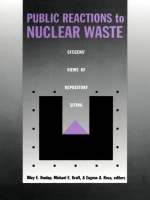 Public Reactions to Nuclear Waste: Citizens’ Views of Repository Siting
Riley E. Dunlap, Michael E. Kraft, and Eugene A. Rosa, eds.
Duke University Press, 1993 Nuclear waste is going nowhere, and neither is the debate over its disposal. The problem, growing every day, has proven intractable, with policymakers on one side, armed with daunting technical data, and the public on the other, declaring: not in my backyard. This timely volume offers a look past our present impasse into the nature and roots of public viewpoints on nuclear waste disposal. A much-needed supplement to the largely technical literature on this problem, the book provides extensive studies of the reaction of citizens--whether rural or urban, near-site residents or prospective visitors--to proposed nuclear waste sites around the nation, particularly Nevada's Yucca Mountain. Conducted by distinguished sociologists, psychologists, political scientists, and economists, these studies constitute the most comprehensive account available of the impact of public perceptions and opinions on the nuclear waste policy process in the United States. As such, the collection will clarify the politics of nuclear waste siting and will give impetus to the stalled debate over the issue. Contributors. Rodney K. Baxter, Julia G. Brody, Bruce Clary, Lori Cramer, William H. Desvousges, Riley E. Dunlap, Douglas Easterling, Judy K. Fleishman, James Flynn, William R. Freudenburg, Michael E. Kraft, Richard S. Krannich, Howard Kunreuther, Mark Layman, Ronald L. Little, Robert Cameron Mitchell, Alvin H. Mushkatel, Joanne M. Nigg, K. David Pijawka, Eugene A. Rosa, Paul Slovic
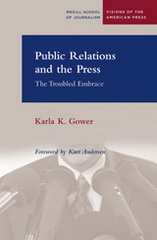 Public Relations and the Press: The Troubled Embrace
Karla Gower
Northwestern University Press, 2007 We are living in what one author describes as “highly promotional times.” Governments and corporations, nonprofits and special interest groups, all have spin doctors trying to turn the news to their advantage. This increasingly incestuous connection between the practitioners of public relations and journalism has resulted in a troubling shift in power. Public Relations and the Press examines how this shift came to be and explores the questions it raises about the role of media in a democratic society and the future of journalism.
A democracy works when individuals have access to reliable information upon which to base decisions—information that in our day comes from the mass media. But what if journalists do not have the wherewithal to question their sources and evaluate the information they provide? This, Karla K. Gower explains, is precisely what happens when economic and competitive pressures shift power from the journalist to the source—and the source, not the journalist, controls the flow of information to the public. Gowers describes a situation in which people, “informed” by practitioners of public relations, do not have sufficient information to make valid decisions. At stake is the core credibility of the press itself, and therefore the essential claim of journalism to a privileged role in a democratic social order.
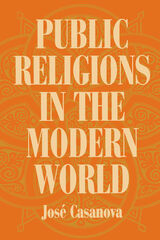 Public Religions in the Modern World
José Casanova
University of Chicago Press, 1994 In a sweeping reconsideration of the relation between religion and modernity, Jose Casanova surveys the roles that religions may play in the public sphere of modern societies.
During the 1980s, religious traditions around the world, from Islamic fundamentalism to Catholic liberation theology, began making their way, often forcefully, out of the private sphere and into public life, causing the "deprivatization" of religion in contemporary life. No longer content merely to administer pastoral care to individual souls, religious institutions are challenging dominant political and social forces, raising questions about the claims of entities such as nations and markets to be "value neutral", and straining the traditional connections of private and public morality.
Casanova looks at five cases from two religious traditions (Catholicism and Protestantism) in four countries (Spain, Poland, Brazil, and the United States). These cases challenge postwar—and indeed post-Enlightenment—assumptions about the role of modernity and secularization in religious movements throughout the world.
This book expands our understanding of the increasingly significant role religion plays in the ongoing construction of the modern world.
Public Response to Peacetime Uses of Atomic Energy: Volume I: Community Differences
Burton R. Fisher, Benjamin J. Darsky, and Charles A. Metzner
University of Michigan Press, 1951 This is Volume 1 of a study of people, reactions, and information, based on a sample interview survey in comparable communities with and without major atomic energy activities. The study was conducted under contract with the United States Atomic Energy Commission. This volume presents aspects of data obtained from a survey of public reactions and information dealing with peacetime uses of atomic energy. Research methods and study objectives are also discussed, and the book includes an appendix containing the questionnaire used in the study.
Public Response to Peacetime Uses of Atomic Energy: Volume II: Individual and Group Analysis
Burton R. Fisher, Benjamin J. Darsky, and Charles A. Metzner
University of Michigan Press, 1951 This is Volume 2 of a study of people, reactions, and information, based on a sample interview survey in comparable communities with and without major atomic energy activities. The study was conducted under contract with the United States Atomic Energy Commission. This volume presents a detailed analysis of individual and group differences in information, attitudes, and opinions, in contrast to the community correlates. The study should be of interest to social scientists as a snapshot of a social process that had only recently begun.
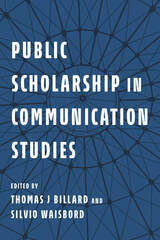 Public Scholarship in Communication Studies
Edited by Thomas J Billard and Silvio Waisbord
University of Illinois Press, 2024 Prometheus brought the gift of enlightenment to humanity and suffered for his benevolence. This collection takes on scholars’ Promethean view of themselves as selfless bringers of light and instead offers a new vision of public scholarship as service to society. Thomas J Billard and Silvio Waisbord curate essays from a wide range of specialties within the study of communication. Aimed at scholars and students alike, the contributors use approaches from critical meditations to case studies to how-to guides as they explore the possibilities of seeing shared knowledge not as a gift to be granted but as an imperative urging readers to address the problems of the world. Throughout the volume, the works show that a pivot to ideas of scholarship as public service is already underway in corners of communication studies across the country. Visionary and provocative, Public Scholarship in Communication Studies proposes a needed reconsideration of knowledge and a roadmap to its integration with community. Contributors: Elaine Almeida, Becca Beets, Thomas J Billard, Danielle K. Brown, Aymar Jean Christian, Stacey L. Connaughton, Paula Gardner, Larry Gross, Amy Jordan, Daniel Kreiss, Rachel Kuo, Susan Mancino, Shannon C. McGregor, Philip M. Napoli, Todd P. Newman, Srividya Ramasubramanian, Chad Raphael, Sue Robinson, Silvio Waisbord, Yidong Wang, and Holley Wilkin
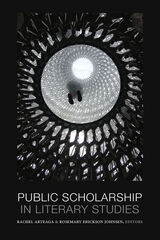 Public Scholarship in Literary Studies
Rachel Arteaga
Amherst College Press, 2021 Public Scholarship in Literary Studies demonstrates that literary criticism has the potential not only to explain, but to actively change our terms of engagement with current realities. Rachel Arteaga and Rosemary Johnsen bring together accomplished public scholars who make significant contributions to literary scholarship, teaching, and the public good. The volume begins with essays by scholars who write regularly for large public audiences in primarily digital venues, then moves to accounts of research-based teaching and engagement in public contexts, and finally turns to important new models for cross-institutional partnerships and campus-community engagement. Grounded in scholarship and written in an accessible style, Public Scholarship in Literary Studies will appeal to scholars in and outside the academy, students, and those interested in the public humanities.
"There are books of literary criticism that attempt to reach crossover audiences but none that take this particular public-humanities-focused-on-literary criticism perspective."—Kathryn Temple, Georgetown University
Contributions by Rachel Arteaga, Christine Chaney, Jim Cocola, Daniel Coleman, Christopher Douglas, Gary Handwerk, Cynthia L. Haven, Rosemary Erickson Johnsen, Anu Taranath, Carmaletta M. Williams, and Lorraine York.
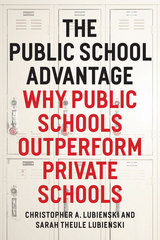 The Public School Advantage: Why Public Schools Outperform Private Schools
Christopher A. Lubienski and Sarah Theule Lubienski
University of Chicago Press, 2013 Nearly the whole of America’s partisan politics centers on a single question: Can markets solve our social problems? And for years this question has played out ferociously in the debates about how we should educate our children. From the growth of vouchers and charter schools to the implementation of No Child Left Behind, policy makers have increasingly turned to market-based models to help improve our schools, believing that private institutions—because they are competitively driven—are better than public ones. With The Public School Advantage, Christopher A. and Sarah Theule Lubienski offer powerful evidence to undercut this belief, showing that public schools in fact outperform private ones.
For decades research showing that students at private schools perform better than students at public ones has been used to promote the benefits of the private sector in education, including vouchers and charter schools—but much of these data are now nearly half a century old. Drawing on two recent, large-scale, and nationally representative databases, the Lubienskis show that any benefit seen in private school performance now is more than explained by demographics. Private schools have higher scores not because they are better institutions but because their students largely come from more privileged backgrounds that offer greater educational support. After correcting for demographics, the Lubienskis go on to show that gains in student achievement at public schools are at least as great and often greater than those at private ones. Even more surprising, they show that the very mechanism that market-based reformers champion—autonomy—may be the crucial factor that prevents private schools from performing better. Alternatively, those practices that these reformers castigate, such as teacher certification and professional reforms of curriculum and instruction, turn out to have a significant effect on school improvement.
Despite our politics, we all agree on the fundamental fact: education deserves our utmost care. The Public School Advantage offers exactly that. By examining schools within the diversity of populations in which they actually operate, it provides not ideologies but facts. And the facts say it clearly: education is better off when provided for the public by the public.
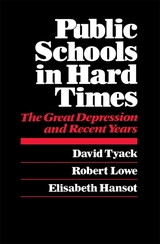 Public Schools in Hard Times: The Great Depression and Recent Years
David Tyack, Robert Lowe, and Elisabeth Hansot
Harvard University Press, 1984 In the first social history of what happened to public schools in those “years of the locust,” the authors explore the daily experience of schoolchildren in many kinds of communities—the public school students of working-class northeastern towns, the rural black children of the South, the prosperous adolescents of midwestern suburbs. How did educators respond to the fiscal crisis, and why did Americans retain their faith in public schooling during the cataclysm? The authors examine how New Dealers regarded public education and the reaction of public school people to the distinctive New Deal style in programs such as the National Youth Administration. They illustrate the story with photographs, cartoons, and vignettes of life behind the schoolhouse door.
Moving from that troubled period to our own, the authors compare the anxieties of the depression decade with the uncertainties of the 1970s and 1980s. Heirs to an optimistic tradition and trained to manage growth, school staff have lately encountered three shortages: of pupils, money, and public confidence. Professional morale has dropped as expectations and criticism have mounted. Changes in the governing and financing of education have made planning for the future even riskier than usual.
Drawing on the experience of the 1930s to illuminate the problems of the 1980s, the authors lend historical perspective to current discussions about the future of public education. They stress the basic stability of public education while emphasizing the unfinished business of achieving equality in schooling.
The Public Schools of Colonial Boston, 1635–1775
Robert Francis Seybolt
Harvard University Press This is the first detailed source-study of the public schools of colonial Boston. Although especially timely in view of the three-hundredth anniversary of the beginnings of the Boston public school system, it is a work of permanent value. Based on verifiable contemporary manuscript and printed records, it corrects much that has been written about the most celebrated of these early establishments, the Public Latin School.
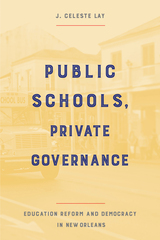 Public Schools, Private Governance: Education Reform and Democracy in New Orleans
J. Celeste Lay
Temple University Press, 2022 Two months after Hurricane Katrina, Louisiana took control of nearly all the public schools in New Orleans. Today, all of the city’s public schools are charter schools. Although many analyses mark the beginning of education reform in New Orleans with Katrina, in Public Schools, Private Governance, J. Celeste Layargues that the storm merely accelerated the timeline for reforms that had inched along incrementally over the previous decade. Both before and after Katrina, white reformers purposely excluded Black educators, community members, and parents. Public Schools, Private Governance traces the slow, deliberate dismantling of New Orleans’ public schools, and the processes that have maintained the reforms made in Katrina’s immediate aftermath, showing how Black parents and residents were left without a voice and the officials charged with school governance, most of whom are white, with little accountability. Lay cogently explains how political minorities disrupted systems to create change and keep reforms in place, and the predictable political effects—exclusion, frustration, and resignation—on the part of those most directly affected.
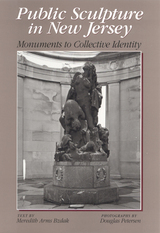 Public Sculpture in New Jersey: Monuments to Collective Identity
Bzdak, Meredith Arms
Rutgers University Press, 1999 New Jersey boasts more than 700 public sculptures. When viewed as a group, these works give us great insights about who helped to shape New Jersey, what events we considered significant, and how we hope we will be remembered. Public Sculpture in New Jersey examines 150 years of past and current patterns in the commissioning and placement of outdoor art in the Garden State. The book contains essays that profile the state’s 100 most significant works as well as the artists who created them, and features nearly 100 magnificent photographs that document these works, capturing the effects of time and the environment on each sculpture. Bzdak and Petersen selected these works for the variety of stories they tell and for their range of artistic expression, from traditional to contemporary, rather than focusing only on the best known or most visible works of public sculpture. By telling the stories behind the sculptures, the book captures New Jersey’s history, especially history that may not be well known but that conveys significant information about how our predecessors lived and the official images they sought to leave behind.
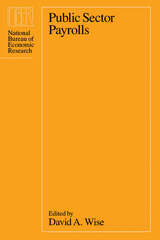 Public Sector Payrolls
Edited by David A. Wise
University of Chicago Press, 1987 An estimated one out of five employees in this country works for some branch of government. Because policies concerning the compensation of these employees rest on assumptions about the economic dynamics of the public sector, the issue of public sector employment is of vital importance in the analysis of the national economy. In Public Sector Payrolls, leading economists explore the independent and interdependent functioning of the public and private sectors and their effect on the economy as a whole.
The volume, developed from a 1984 National Bureau of Economic Research conference, focuses on various labor issues in military and other governmental employment. Several contributors discuss compensation in the armed forces and its relationship to that in the private sector, as well as the interaction between the military and the private sector in the employment of youth. This latter is of particular interest because studies of youth employment have generally ignored the important influence of military hiring practices on labor market conditions. In other contributions, the response of wages and employment in the public sector to economic conditions is analyzed, and a detailed study of government pension plans is presented. Also included is a theoretical and empirical analysis of comparable worth in the public sector from the viewpoint of analytical labor economics. The volume concludes with a look at public school teachers' salaries in the context of current debates over improving the quality of American education.
A valuable resource to policymakers, Public Sector Payrolls will be an important addition to research in the field of labor economics.
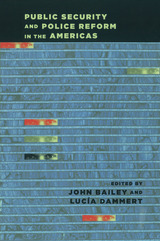 Public Security and Police Reform in the Americas
John Bailey
University of Pittsburgh Press, 2005 The events of September 11, 2001, combined with a pattern of increased crime and violence in the 1980s and mid-1990s in the Americas, has crystallized the need to reform government policies and police procedures to combat these threats. Public Security and Police Reform in the Americas examines the problems of security and how they are addressed in Latin America and the United States. Bailey and Dammert detail the wide variation in police tactics and efforts by individual nations to assess their effectiveness and ethical accountability. Policies on this issue can take the form of authoritarianism, which threatens the democratic process itself, or can, instead, work to “demilitarize” the police force. Bailey and Dammert argue that although attempts to apply generic models such as the successful “zero tolerance” created in the United States to the emerging democracies of Latin America—where institutional and economic instabilities exist—may be inappropriate, it is both possible and profitable to consider these issues from a common framework across national boundaries. Public Security and Police Reform in the Americas lays the foundation for a greater understanding of policies between nations by examining their successes and failures and opens a dialogue about the common goal of public security.
 The Public Service Media and Public Service Internet Manifesto
Christian Fuchs and Klaus Unterberger
University of Westminster Press, 2021 This book presents the collectively authored Public Service Media and Public Service Internet Manifesto and accompanying materials.The Internet and the media landscape are broken. The dominant commercial Internet platforms endanger democracy. They have created a communications landscape overwhelmed by surveillance, advertising, fake news, hate speech, conspiracy theories, and algorithmic politics. Commercial Internet platforms have harmed citizens, users, everyday life, and society. Democracy and digital democracy require Public Service Media. A democracy-enhancing Internet requires Public Service Media becoming Public Service Internet platforms – an Internet of the public, by the public, and for the public; an Internet that advances instead of threatens democracy and the public sphere. The Public Service Internet is based on Internet platforms operated by a variety of Public Service Media, taking the public service remit into the digital age. The Public Service Internet provides opportunities for public debate, participation, and the advancement of social cohesion. Accompanying the Manifesto are materials that informed its creation: Christian Fuchs’ report of the results of the Public Service Media/Internet Survey, the written version of Graham Murdock’s online talk on public service media today, and a summary of an ecomitee.com discussion of the Manifesto’s foundations. The Manifesto can be signed by visiting http://bit.ly/signPSManifesto
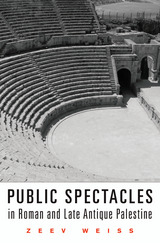 Public Spectacles in Roman and Late Antique Palestine
Zeev Weiss
Harvard University Press, 2014 Public Spectacles in Roman and Late Antique Palestine introduces readers to the panoply of public entertainment that flourished in Palestine from the first century BCE to the sixth century CE. Drawing on a trove of original archaeological and textual evidence, Zeev Weiss reconstructs an ancient world where Romans, Jews, and Christians intermixed amid a heady brew of shouts, roars, and applause to watch a variety of typically pagan spectacles.
Ancient Roman society reveled in many such spectacles—dramatic performances, chariot races, athletic competitions, and gladiatorial combats—that required elaborate public venues, often maintained at great expense. Wishing to ingratiate himself with Rome, Herod the Great built theaters, amphitheaters, and hippodromes to bring these forms of entertainment to Palestine. Weiss explores how the indigenous Jewish and Christian populations responded, as both spectators and performers, to these cultural imports. Perhaps predictably, the reactions of rabbinic and clerical elites did not differ greatly. But their dire warnings to shun pagan entertainment did little to dampen the popularity of these events.
Herod’s ambitious building projects left a lasting imprint on the region. His dream of transforming Palestine into a Roman enclave succeeded far beyond his rule, with games and spectacles continuing into the fifth century CE. By then, however, public entertainment in Palestine had become a cultural institution in decline, ultimately disappearing during Justinian’s reign in the sixth century.
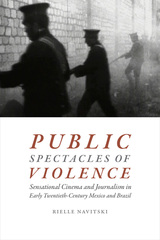 Public Spectacles of Violence: Sensational Cinema and Journalism in Early Twentieth-Century Mexico and Brazil
Rielle Navitski
Duke University Press, 2017 In Public Spectacles of Violence Rielle Navitski examines the proliferation of cinematic and photographic images of criminality, bodily injury, and technological catastrophe in early twentieth-century Mexico and Brazil, which were among Latin America’s most industrialized nations and later developed two of the region’s largest film industries. Navitski analyzes a wide range of sensational cultural forms, from nonfiction films and serial cinema to illustrated police reportage, serial literature, and fan magazines, demonstrating how media spectacles of violence helped audiences make sense of the political instability, high crime rates, and social inequality that came with modernization. In both nations, sensational cinema and journalism—influenced by imported films—forged a common public sphere that reached across the racial, class, and geographic divides accentuated by economic growth and urbanization. Highlighting the human costs of modernization, these media constructed everyday experience as decidedly modern, in that it was marked by the same social ills facing industrialized countries. The legacy of sensational early twentieth-century visual culture remains felt in Mexico and Brazil today, where public displays of violence by the military, police, and organized crime are hypervisible.
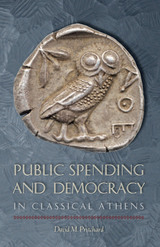 Public Spending and Democracy in Classical Athens
By David M. Pritchard
University of Texas Press, 2015 In his On the Glory of Athens, Plutarch complained that the Athenian people spent more on the production of dramatic festivals and “the misfortunes of Medeas and Electras than they did on maintaining their empire and fighting for their liberty against the Persians.” This view of the Athenians’ misplaced priorities became orthodoxy with the publication of August Böckh’s 1817 book Die Staatshaushaltung der Athener [The Public Economy of Athens], which criticized the classical Athenian dēmos for spending more on festivals than on wars and for levying unjust taxes to pay for their bloated government. But were the Athenians’ priorities really as misplaced as ancient and modern historians believed? Drawing on lines of evidence not available in Böckh’s time, Public Spending and Democracy in Classical Athens calculates the real costs of religion, politics, and war to settle the long-standing debate about what the ancient Athenians valued most highly. David M. Pritchard explains that, in Athenian democracy, voters had full control over public spending. When they voted for a bill, they always knew its cost and how much they normally spent on such bills. Therefore, the sums they chose to spend on festivals, politics, and the armed forces reflected the order of the priorities that they had set for their state. By calculating these sums, Pritchard convincingly demonstrates that it was not religion or politics but war that was the overriding priority of the Athenian people.
 Public Spheres, Private Lives in Modern Japan, 1600–1950: Essays in Honor of Albert M. Craig
Gail Lee Bernstein
Harvard University Press, 2005 The eleven chapters in this volume explore the process of carving out, in discourse and in practice, the boundaries delineating the state, the civil sphere, and the family in Japan from 1600 to 1950.
One of the central themes in the volume is the demarcation of relations between the central political authorities and local communities. The early modern period in Japan is marked by a growing sense of a unified national society, with a long, common history, that existed in a coherent space. The growth of this national community inevitably raised questions about relationships between the imperial government and local groups and interests at the prefectural and village levels. Moves to demarcate divisions between central and local rule in the course of constructing a modern nation contributed to a public discourse that drew on longstanding assumptions about political legitimacy, authority, and responsibility as well as on Western political ideas.
Public Spirit in the Thrift Tragedy
Mark Carl Rom
University of Pittsburgh Press, 1996
Winner of the Harold Lasswell Award of the American Political Science Association
The FSFIC failed spectacularly during the 1980s, costing taxpayers an estimated $200 billion. In this award-winning analysis, Rom examines the political causes of this “thrift tragedy.” He directly confronts-and rejects-the dominant scholarly “public choice” view that public officials were motivated mainly be self-interest. Instead, Rom argues that politicians and bureaucrats generally acted in the “public spirit” by attempting to obtain the common interest as they saw it. Using new evidence and innovative methods, Rom demonstrates that FSLIC's failure unfolded because of commitments that officials had made in the past and their uncertainties about how to fulfill these obligations in the future.
 Public Subsidy, Private Accumulation: The Political Economy of Singapore's Public Housing
Beng Huat Chua
National University of Singapore Press, 2024 Examines the ways Singapore’s impressive public housing program is central to the political legitimacy of the city-state’s single-party regime, and the growing contradictions of its success.
The achievement of Singapore’s national public housing program is impressive by any standard. Within a year of its first election victory in 1959, the People's Action Party began to deliver on its promises. By the 1980s, 85% of the population had been rehoused in modern flats. Now, decades later, the provision of public housing shapes Singapore's environment. The standard accounts of this remarkable transformation leave many questions unanswered, from the historical to urgent matters of current policy. Why was housing such a priority in the 1960s? How did the provision of social welfare via public housing shape Singapore's industrialization and development over the last 50 years? Looking forward, can the HDB continue to be both a source of affordable housing for young families and a mechanism for retirement savings? What will happen when 99-year leases expire?
Public Subsidy, Private Accumulation is a culmination of Chua Beng Huat's study of Singapore's public housing system, its dynamics, and the ways it functions in Singapore's politics. The book will be of interest to citizens and to scholars of the political economy of Asian development, social welfare provision, and Singapore.
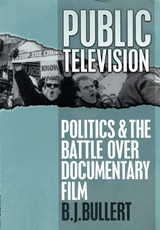 Public Television: Politics and the Battle over Documentary Film
Bullert, B.J.
Rutgers University Press, 1997 Public television's original mandate requires the system to address issues of controversy and facilitate the inclusion of voices and perspectives that lie outside the established consensus. But attempts to include these voices reveal a system riddled with conflicting obligations and agendas. Public Television looks at who in the world of public television is powerful, who is weak, and who cares. Through detailed chronologies, B. J. Bullert traces how independently produced documentaries pushed the limits of public television between 1985 and 1993. She interviews the key players, film makers, programmers, journalists, and representatives of interest groups to illuminate how together they sought to frame and constrain viewers on perceptions of provocative works. Their stories are set against the backdrop of a larger story about the relationship between federal funding for the arts and public broadcasting and the promise of a democratic society. Bullert brings to light the subtle forces and interests that effectively control the style and content of documentaries that have been broadcast with the PBS logo. When film makers brought uncommon realities to the public television airwaves, a complex collective response from station programmers, interest groups, journalists, and viewers ensued. Public Television charts the communication process through which visions of reality deemed threatening to some are packaged to make them more palatable for public television viewers.
Public Use of the Library and Other Sources of Information
Angus Campbell and Charles A. Metzner
University of Michigan Press, 1950 This short book presents the findings of a survey on the use of public libraries. The survey was conducted by the Social Science Research Council in 1947 under the auspices of the American Library Association, and conducted. Chapters cover materials housed in libraries, demographic findings on who uses libraries, and data on why patrons use libraries. The final chapter covers more speculative questions posed to the subjects of the study on new, extended services that libraries might offer in the future.
 Public Value and Public Administration
John M. Bryson, Barbara C. Crosby, and Laura Bloomberg, Editors
Georgetown University Press, 2015 Governments and nonprofits exist to create public value. Yet what does that mean in theory and practice? This new volume brings together key experts in the field to offer unique, wide-ranging answers. From the United States, Europe, and Australia, the contributors focus on the creation, meaning, measurement, and assessment of public value in a world where government, nonprofit organizations, business, and citizens all have roles in the public sphere. In so doing, they demonstrate the intimate link between ideas of public value and public values and the ways scholars theorize and measure them. They also add to ongoing debates over what public value might mean, the nature of the most important public values, and how we can practically apply these values. The collection concludes with an extensive research and practice agenda conceived to further the field and mainstream its ideas. Aimed at scholars, students, and stakeholders ranging from business and government to nonprofits and activist groups, Public Value and Public Administration is an essential blueprint for those interested in creating public value to advance the common good.
 Public Values and Public Interest: Counterbalancing Economic Individualism
Barry Bozeman
Georgetown University Press, 2007 Economic individualism and market-based values dominate today's policymaking and public management circles—often at the expense of the common good. In his new book, Barry Bozeman demonstrates the continuing need for public interest theory in government. Public Values and Public Interest offers a direct theoretical challenge to the "utility of economic individualism," the prevailing political theory in the western world. The book's arguments are steeped in a practical and practicable theory that advances public interest as a viable and important measure in any analysis of policy or public administration. According to Bozeman, public interest theory offers a dynamic and flexible approach that easily adapts to changing situations and balances today's market-driven attitudes with the concepts of common good advocated by Aristotle, Saint Thomas Aquinas, John Locke, and John Dewey. In constructing the case for adopting a new governmental paradigm based on what he terms "managing publicness," Bozeman demonstrates why economic indices alone fail to adequately value social choice in many cases. He explores the implications of privatization of a wide array of governmental services—among them Social Security, defense, prisons, and water supplies. Bozeman constructs analyses from both perspectives in an extended study of genetically modified crops to compare the policy outcomes using different core values and questions the public value of engaging in the practice solely for the sake of cheaper food. Thoughtful, challenging, and timely, Public Values and Public Interest shows how the quest for fairness can once again play a full part in public policy debates and public administration.
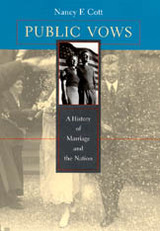 Public Vows: A History of Marriage and the Nation
Nancy F. Cott
Harvard University Press, 2001 We commonly think of marriage as a private matter between two people, a personal expression of love and commitment. In this pioneering history, Nancy F. Cott demonstrates that marriage is and always has been a public institution.
From the founding of the United States to the present day, imperatives about the necessity of marriage and its proper form have been deeply embedded in national policy, law, and political rhetoric. Legislators and judges have envisioned and enforced their preferred model of consensual, lifelong monogamy--a model derived from Christian tenets and the English common law that posits the husband as provider and the wife as dependent.In early confrontations with Native Americans, emancipated slaves, Mormon polygamists, and immigrant spouses, through the invention of the New Deal, federal income tax, and welfare programs, the federal government consistently influenced the shape of marriages. And even the immense social and legal changes of the last third of the twentieth century have not unraveled official reliance on marriage as a "pillar of the state."
By excluding some kinds of marriages and encouraging others, marital policies have helped to sculpt the nation's citizenry, as well as its moral and social standards, and have directly affected national understandings of gender roles and racial difference. Public Vows is a panoramic view of marriage's political history, revealing the national government's profound role in our most private of choices. No one who reads this book will think of marriage in the same way again.
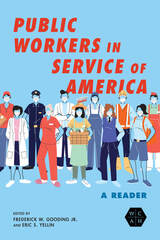 Public Workers in Service of America: A Reader
Edited by Frederick W. Gooding Jr. and Eric S. Yellin
University of Illinois Press, 2023 From white-collar executives to mail carriers, public workers meet the needs of the entire nation. Frederick W. Gooding Jr. and Eric S. Yellin edit a collection of new research on this understudied workforce. Part One begins in the late nineteenth- and early twentieth century to explore how questions of race, class, and gender shaped public workers, their workplaces, and their place in American democracy. In Part Two, essayists examine race and gender discrimination while revealing the subtle contemporary forms of marginalization that keep Black men and Black and white women underpaid and overlooked for promotion. The historic labor actions detailed in Part Three illuminate how city employees organized not only for better pay and working conditions but to seek recognition from city officials, the public, and the national labor movement. Part Four focuses on nurses and teachers to address the thorny question of whether certain groups deserve premium pay for their irreplaceable work and sacrifices or if serving the greater good is a reward unto itself. Contributors: Eileen Boris, Cathleen D. Cahill, Frederick W. Gooding Jr., William P. Jones, Francis Ryan, Jon Shelton, Joseph E. Slater, Katherine Turk, Eric S. Yellin, and Amy Zanoni
 Public Works: Infrastructure, Irish Modernism, and the Postcolonial
Michael Rubenstein
University of Notre Dame Press, 2010
In Public Works: Infrastructure, Irish Modernism, and the Postcolonial, Michael Rubenstein documents the relationship between Irish modernism and a restricted segment of the material culture of the modern state known colloquially as "public utilities" or "water, gas, and electricity." The water tap, the toilet, the gas jet, and the electrical light switch: these are all sites, in Irish modernism, of unexpected literary and linguistic intensities that burst through the routines of everyday life, defamiliarizing and reconceptualizing that which we might not normally consider worthy of literary attention. Such public utilities--material networks of power and provision, submission and entitlement--are taken up in Irish modernism not only as a nexus of anxieties about modern life, but also as a focal point for the hopes held out for the postcolonial Irish Free State. Public utilities figure a normative and utopian standard of modernity and modernization; they embody in Irish modernism and in other postcolonial literatures an ideal for the postcolonial state; and they figure a continuity between the material networks of the modern state and the abstract ideals of revolutionary republicanism (liberty, equality, and brotherhood). They define a new territory of contestation within the discourses of civil and human rights. Moreover, public utilities influence the formal qualities of both Irish modernist and postcolonial literature.
In analyses of literary works by James Joyce, Flann O'Brien, Elizabeth Bowen, Denis Johnston, Samuel Beckett, and Patrick Chamoiseau, Rubenstein asks us to think about the industrial networks of the twentieth century alongside self-consciously "national" literary works and to understand them as different but inherently related forms of public works. In doing so his book maps thematic and formal relationships between national infrastructure and national literature, revealing an intimate dialogue between the nation's literary arts and the state's engineering cultures.
"Public Works, Michael Rubenstein's pathbreaking book, brilliantly explores relationships between modern 'engineering cultures' and literary cultures. Juxtaposing literary texts and electric power generators, plays and water schemes, he offers us nothing less than a new way to read literary modernism's engagement with the real. His book represents a major intervention in postcolonial studies, uncovering new and pragmatic models of imagined community after colonialism. Additionally, Rubenstein's work marks a significant move in contemporary Irish studies by developing paradigms that help us read Ireland's postcolonial statehood in a global context. It also offers highly original readings of a series of Irish late-modernist writers, all in a timely and truly interdisciplinary project, beautifully done." --Enda Duffy, University of California, Santa Barbara
". . . one of the most original and important contributions to Irish studies, and to a number of other fields as well, that has been written by a young scholar in recent years. It will be an important and much discussed book. It participates in, and outlines the future of, significant new directions in areas such as Irish studies, modernist studies, postcolonial studies, and the study of the relations among technology, materiality, and culture." --Marjorie Howes, Boston College
"Can you imagine a Joycean appeal for the payment of taxes? If you do not find it easy, you may be ready to take in the superb literary flair and pitch-perfect sense of present urgencies that putsPublic Worksat the sharpest edge of new scholarship. Michael Rubenstein makes a tiger's leap into the recent past, when the intimacy of the home had not yet learned to take for granted its connection to networks of electricity, gas, and water. He has written the book on the very hot topic of infrastructure, and he's done so while also figuring out a new direction for postcolonial studies. You will never be able to read Ulysses the same way again." --Bruce Robbins, Columbia University
Publications of the Astronomical Observatory of the University of Michigan: Volume II
Detroit Observatory
University of Michigan Press, 1916 A large reflecting telescope of the Cassegrain form, having an aperture of 37.5 inches and an equivalent focal length of 60 feet, was designed and constructed at the Astronomical Observatory of the University of Michigan. More than 3700 spectrograms have now been made, and nearly all the papers in Publications of the Astronomical Observatory of the University of Michigan are based upon data obtained from a small portion of the spectrograms.
 Public-Private Partnerships for Public Health
Michael R. Reich
Harvard University Press, 2002 Global health problems require global solutions, and public–private partnerships are increasingly called upon to provide these solutions. Such partnerships involve private corporations in collaboration with governments, international agencies, and nongovernmental organizations. They can be very productive, but they also bring their own problems. This volume examines the organizational and ethical challenges of partnerships and suggests ways to address them. How do organizations with different values, interests, and world-views come together to resolve critical public health issues? How are shared objectives and shared values created within a partnership? How are relationships of trust fostered and sustained in the face of the inevitable conflicts, uncertainties, and risks of partnership?
This book focuses on public–private partnerships that seek to expand the use of specific products to improve health conditions in poor countries. The volume includes case studies of partnerships involving specific diseases such as trachoma and river blindness, international organizations such as the World Health Organization, multinational pharmaceutical companies, and products such as medicines and vaccines. Individual chapters draw lessons from successful partnerships as well as troubled ones in order to help guide efforts to reduce global health disparities.
 The Public's Health: A Narrative History Of Health And Disease In Arkansas
Sam Taggert
Arkansas Times Press, 2013 August 1st, 1878 The preceding winter had been mild, the spring and summer was hot and rainy; there were mosquitoes everywhere. "Yellow Jack" had been reported in New Orleans. William Warren, a steamboat crewman at Presidents Island just south of Memphis, left his ship and entered the city. One day later he was admitted to the City Hospital and two days hence he was dead of yellow fever. When word got out of a yellow fever death in the city the citizens began to flee. Schools and churches closed their doors. Passenger boat services from New Orleans were forced to disembark their passengers on the Arkansas side. In the end 5,100 people died in the city of Memphis. The hardest-hit towns in Arkansas were Helena, Hopefield (West Memphis) and Augusta on the White River. Trains and boats entering the state of Arkansas were quarantined. Many little towns across the Delta established "shotgun" quarantines: if you weren’t recognized by the men manning the barrier, you were asked to leave through the sights of a gun. Smallpox,malaria, tuberculosis, cholera, yellow fever were ever present dangers in nineteenth and early twentieth century Arkansas. This story is a narrative history of the health and disease of the people of Arkansas, what they faced and how they dealt with it.
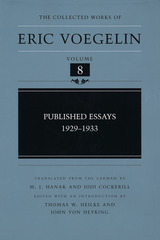 Published Essays, 1929-1933 (CW8)
Eric Voegelin & Edited, Translated, & Intro by Thomas W. Heilke & John von Heyking
University of Missouri Press, 2003 This volume of The Collected Works contains essays published by Eric Voegelin between 1929 and 1933, the period between the publication of his first book, On the Form of the American Mind, and Hitler's rise to power, as well as Voegelin's two books analyzing the explosive race issues posed by National Socialism. The essays herein reflect the intellectual and political tumult of the period and their author's maturing grasp of political reality as he moved away from positivism and Kelsen's "Pure Theory of Law" toward a more refined and open philosophical stance. The heart of this shift is signaled by his emphasis on philosophical anthropology and on the decisive importance of the moral substance basic to political communities. The topics of the essays are grouped around major themes in sociological theory, political science, and the theory of law. They illuminate the theoretical and practical impact of Voegelin's experiences in America as he increasingly engages European theories of state, especially the social theories of leading French and German scholars. In content, these essays include such pragmatic concerns as American theories of property, economic transactions, due process of law, and Austrian constitutional reforms. Voegelin also explores the technically complex speculative matters surrounding sovereignty and law, Max Weber's science, and the spiritual form of Europe. He analyzes Kant's understanding of moral duty and the meaning of solidarity as the substance of democratic society. Through these discourses, readers can see how the theme of divine transcendence increasingly finds expression during this crucial early stage of Voegelin's scholarly life. Thus, these studies mark the early path Voegelin took in making his arduous journey from legal scholar to philosophical political scientist. They display his increasingly resolute attention-- against challenges both existential and urgently political--to a growing insight into what it means to be fully human as he struggles toward an eventual philosophy of politics and history sufficient to amplify that noble insight.
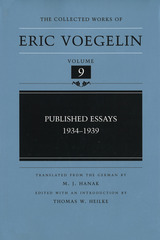 Published Essays, 1934-1939 (CW9)
Eric Voegelin, Edited & Intro by Thomas W. Heilke, & Translated by M. J. Hanak
University of Missouri Press, 2001 In this collection of essays, which covers the years from 1934 to1939, we see Eric Voegelin in the role of both scholar and public intellectual in Vienna until he was forced to flee the Nazi terror that descended on Austria in 1938. Revealing the broad spectrum of thinking and scientific study of this relatively young scholar, Voegelin's essays range from Austrian politics, Austrian constitutional history, and European racism to questions of the formation and expression of public opinion, theories of administrative law, and the role of political science in public university education. Several essays serve as useful commentaries on, elaborations of, or synopses of arguments Voegelin made in the five books he had published between 1928 and 1938. Within these topical headings, there are multiple thematic threads that wind their way through these essays and that remain of interest to contemporary readers. Thirteen of the pieces contained in this collection are short items that Voegelin published in trade journals and newspapers, of which nine appeared in the Wiener Zeitung in 1934 and the Neue Freie Presse in 1937. In these we see two brief periods in which Voegelin played the role of public intellectual not only as a lecturer but also in print. These essays will be of interest to a wide range of scholars, including constitutional historians, historians of political science, political theorists, and students of Voegelin's later work.
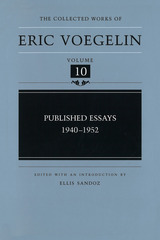 Published Essays, 1940-1952 (CW10)
Eric Voegelin & Edited & Intro by Ellis Sandoz.
University of Missouri Press, 2000 Published Essays, 1940-1952, includes some of Eric Voegelin's most provocative and interesting essays. Containing his first publications after he fled Vienna and settled in the United States following Hitler's annexation of Austria, this volume provides eyewitness commentary on the rise of National Socialism from the first days of World War II onward. A major study entitled "Growth of the Race Idea" presents a masterful summary of the two volumes on that subject Voegelin first published in 1933. A related essay of wide interest is entitled "Nietzsche, the Crisis, and the War." Another facet of Voegelin's thought incorporated within this volume of the Essays is his extraordinary analysis of the diplomatic correspondence conducted between the Western powers, the papacy, and the Great Khans, whose breathtaking expansion of the Mongol Empire for a time threatened to extinguish Western civilization itself and resulted in a two-century domination of Russia. Another major study is "The Origins of Scientism," an illuminating analysis of the grounds of much of modern philosophy and of all modern political ideologies. There are also surveys of the state of political theory in the late forties, penetrating studies of utopian thought with essays on Thomas More and Goethe, and a concluding essay that explores the intricacies of "Gnostic Politics"—a familiar theme from Voegelin's contemporaneous New Science of Politics. This volume of published essays shows Eric Voegelin at his most accessible best.
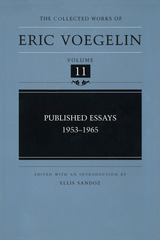 Published Essays, 1953-1965 (CW11)
Eric Voegelin & Edited & Intro by Ellis Sandoz
University of Missouri Press, 2000 The period covered by the material published in this volume marks the transition in Eric Voegelin's career from Louisiana to Munich. After twenty years in the United States, in 1958 Voegelin accepted an invitation to fill the political science chair at Ludwig Maximilian University, a position left vacant throughout the Nazi period and last occupied by the famous Max Weber, who had died in 1920. The themes most prominent in the fourteen items reprinted here reflect the concerns of a transition, not only in a scholar's career, and in the momentous shifts in world politics taking place around him, but also in the development of his understanding of the stratification of reality and the attendant demands for a science of human affairs adequate to the challenges posed by the persistent crisis of the West in its latest configurations and by contemporary philosophy. Several of the items herein originated as talks to a specific organization on problems facing German democratization and the development of a market economy amid the ruins of a fragmented culture and infrastructure in a society without historically evolved institutional supports for a satisfactory social and political order. Accordingly, pragmatic matters occupy a central place in a number of these pieces, especially the overriding question of how Germany could move from an illiberal and ideological political order into a modern liberal democratic one. Those accustomed to the theoretical profundity of Voegelin's writings may find welcome relief in the down-to-earth, commonsensical drift of this material addressed, often, to laymen and businessmen. But, of course, the philosophical subject matter lurks everywhere. It finds full expression in several instances as the controlling context of even the least pretentious presentations. One of the attractions of these essays is what the author brings forward as serviceable elementary guideposts under adverse conditions of intellectual disarray, social decay, and turmoil.
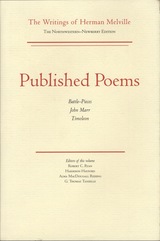 Published Poems: The Writings of Herman Melville Vol. 11
Herman Melville
Northwestern University Press, 2009 Although he surprised the world in 1866 with his first published book of poetry, Battle-Pieces and Aspects of the War, Herman Melville had long been steeped in poetry. This new offering in the authoritative Northwestern-Newberry series, The Writings of Herman Melville, with a historical note by Hershel Parker, is testament to Melville the poet. Penultimate in the publication of the series, Published Poems follows the release of Melville’s verse epic, Clarel (1876), and with it, contains the entirety of the poems published during Melville’s lifetime: Battle-Pieces, as well as John Marr and Other Sailors, with Some Sea-Pieces (1888), and Timoleon Etc. (1891). Battle-Pieces and Aspects of the War has long been recognized as a great contribution to the poetry of the Civil War, comparable only to Whitman’s Drum-Taps. Its idiosyncrasies, many of them grounded in British poetry, kept it from immediate popularity, but it was not the production of a novice. Melville had made himself over into a poet in the late 1850s and had tried to publish a previous collection of poetry—now lost—in 1860. John Marr and Other Sailors is a retrospective nautical book. Its portraits of sailors were influenced by Melville’s own experience of aging as well as by his long acquaintance with wasted mariners at the Sailors’ Snug Harbor on Staten Island, where his brother was governor. The book modulates into "Sea-Pieces," including the grisly "Maldive Shark" and "To Ned," a powerful reflection on how Melville’s personal adventures with the Typee islanders in 1842 had accrued rich historical significance over the decades. Thematically less unified, Timoleon Etc. contains poems with many European and exotic settings from ancient to modern times. The most famous are "After the Pleasure Party" and "The Age of the Antonines." Published in the last year of Melville’s life, some of the poems were first written many years earlier; for example, Melville copied "The Age of the Antonines" out for his brother-in-law in 1877, describing it as something found in a bundle of old papers. One whole section seems to have been almost entirely salvaged from the unpublished 1860 volume of poetry. As with the other volumes in the Northwestern-Newberry series, the aim of this edition of Published Poems is to present a text as close to the author’s intention as surviving evidence permits. To that end, the editorial appendix includes a historical note by Hershel Parker, the dean of Melville scholars, which gives a compelling, in-depth account of how one of America’s greatest writers grew into the vocation of a poet; an essay by G. Thomas Tanselle on the printing and publishing history of the works in Published Poems; a textual record that identifies the copy-texts for the present edition and explains the editorial policy; and substantial scholarly notes on individual poems.
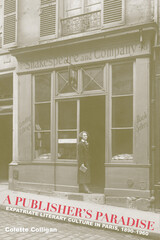 A Publisher's Paradise: Expatriate Literary Culture in Paris, 1890-1960
Colette Colligan
University of Massachusetts Press, 2014 From 1890 to 1960, some of Anglo-America's most heated cultural contests over books, sex, and censorship were staged not at home, but abroad in the City of Light. Paris, with its extraordinary liberties of expression, became a special place for interrogating the margins of sexual culture and literary censorship, and a wide variety of English language "dirty books" circulated through loose expatriate publishing and distribution networks.
A Publisher's Paradise explores the political and literary dynamics that gave rise to this expatriate cultural flourishing, which included everything from Victorian pornography to the most daring and controversial modernist classics. Colette Colligan tracks the British and French politicians and diplomats who policed Paris editions of banned books and uncovers offshore networks of publishers, booksellers, authors, and readers. She looks closely at the stories the "dirty books" told about this publishing haven and the smut peddlers and literary giants it brought together in transnational cultural formations. The book profiles an eclectic group of expatriates living and publishing in Paris, from relatively obscure figures such as Charles Carrington, whose list included both The Picture of Dorian Gray and the pornographic novel Randiana, to bookshop owner Sylvia Beach, famous for publishing James Joyce's Ulysses in 1922.
A Publisher's Paradise is a compelling exploration of the little-known history of foreign pornography in Paris and the central role it played in turning the city into a modernist outpost for literary and sexual vanguardism, a reputation that still lingers today in our cultural myths of midnight in Paris.
 Publishing Beyond the Market: Open Access, Care, and the Commons
Samuel A. Moore
University of Michigan Press, 2025 Publishing Beyond the Market argues that the move to open access should focus less on the free accessibility of research outputs and more on who controls the publications and infrastructures for scholarly communication. By deploying theoretical literature on science and technology studies, care ethics, and the commons, the book critically interrogates open access and reimagines a more ethical future for researcher-led publishing. A case study of Plan S—the multifunder European policy for open access publishing—explores its tendency to rehearse all the failures of commercialisation. Through critical engagement with the open access landscape, the book reveals the shortcomings of market-centric and policy-based approaches to open access book and journal publishing, particularly their tendency to reinforce conservatism, commercialism, and private control of publishing.
Going forward, Publishing Beyond the Market explores the importance of collectivity and democratic governance within the transition to open access publishing. It suggests that developing a commons-based, scholar-led publishing landscape through a series of presses that are each managed by working academics could offer a productive counterpoint to marketised systems of open access and subscription publishing. In weaving themselves together in order to “scale small” these publishing initiatives would act as a counter-hegemonic project based on mutual reliance and care. By illustrating how these projects build toward a commons-based publishing future, and how they may complement other approaches to publishing within university presses and libraries, the book culminates in an argument for the infrastructures, policies, and forms of governance needed to nurture such a collective vision.
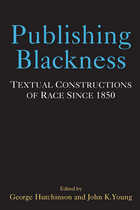 Publishing Blackness: Textual Constructions of Race Since 1850
George Hutchinson and John K. Young, Editors
University of Michigan Press, 2013 From the white editorial authentication of slave narratives, to the cultural hybridity of the Harlem Renaissance, to the overtly independent publications of the Black Arts Movement, to the commercial power of Oprah's Book Club, African American textuality has been uniquely shaped by the contests for cultural power inherent in literary production and distribution. Always haunted by the commodification of blackness, African American literary production interfaces with the processes of publication and distribution in particularly charged ways. An energetic exploration of the struggles and complexities of African American print culture, this collection ranges across the history of African American literature, and the authors have much to contribute on such issues as editorial and archival preservation, canonization, and the "packaging" and repackaging of black-authored texts. Publishing Blackness aims to project African Americanist scholarship into the discourse of textual scholarship, provoking further work in a vital area of literary study.
 Publishing Latinidad: Latinx Literary and Intellectual Production, 1880–1960
Jose O. Fernandez
University of Arizona Press, 2025 Publishing Latinidad brings to light the overlooked contributions of early Latinx writers and intellectuals, offering a fresh perspective on their roles in shaping American literary and cultural landscapes. Jose O. Fernandez meticulously examines the works of notable figures like José Martí, Arturo Schomburg, Jesús Colón, José de la Luz Sáenz, Adela Sloss-Vento, and Américo Paredes, illuminating their innovative approaches to circumventing exclusionary practices in the publishing world. He demonstrates how these writers and intellectuals entered literary, cultural, and intellectual discourses through alternative modes of literary production: crónicas, translations, paratexts, bibliographies, archival practices, sketches, diaries, biographies, unpublished fiction, and scholarly monographs. Through these examples, Fernandez situates Latinx literary production in this time period within the broader context of racial and ethnic solidarity movements in the United States. Publishing Latinidad is essential reading for anyone interested in the social and cultural underpinnings of Latinx literature and intellectual thought. It challenges traditional narratives and enriches our appreciation of the diverse voices that have long been instrumental in the fight for justice.
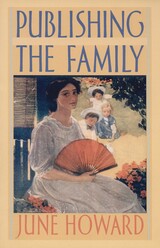 Publishing the Family
June Howard
Duke University Press, 2001 In Publishing the Family June Howard turns a study of the collaborative novel The Whole Family into a lens through which to examine American literature and culture at the beginning of the twentieth century. Striving to do equal justice to historical particulars and the broad horizons of social change, Howard reconsiders such categories of analysis as authorship, genre, and periodization. In the process, she offers a new method for cultural studies and American studies at the beginning of the twenty-first century.
Publishing the Family describes the sources and controversial outcome of a fascinating literary experiment. Howard embeds the story of The Whole Family in the story of Harper & Brothers’ powerful and pervasive presence in American cultural life, treating the publisher, in effect, as an author.
Each chapter of Publishing the Family casts light on some aspect of life in the United States at a moment that arguably marked the beginning of our own era. Howard revises common views of the turn-of-the-century literary marketplace and discusses the perceived crisis in the family as well as the popular and expert discourses that emerged to remedy it. She also demonstrates how creative women like Bazar editor Elizabeth Jordan blended their own ideas about the “New Woman” with traditional values. Howard places these analyses in the framework of far-reaching historical changes, such as the transformation of the public meaning of emotion and “sentimentality.” Taken together, the chapters in Publishing the Family show how profoundly the modern mapping of social life relies on boundaries between family and business, culture and commerce, which The Whole Family and Publishing the Family constantly unsettle.
Publishing the Family will interest students and scholars of American history, literature, and culture, as well as those studying gender, sexuality, and the family.
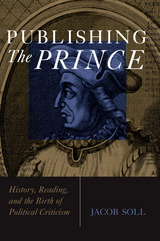 Publishing The Prince: History, Reading, and the Birth of Political Criticism
Jacob Soll
University of Michigan Press, 2010 As new ideas arose during the Enlightenment, many political thinkers published their own versions of popular early modern "absolutist" texts and transformed them into manuals of political resistance. As a result, these works never achieved a fixed and stable edition. Publishing The Prince illustrates how Abraham-Nicolas Amelot de La Houssaye created the most popular late seventeenth- and eighteenth-century version of Machiavelli's masterpiece. In the process of translating, Amelot also transformed the work, altering its form and meaning, and his ideas spread through later editions. Revising the orthodox schema of the public sphere in which political authority shifted away from the crown with the rise of bourgeois civil society in the eighteenth century, Soll uses the example of Amelot to show for the first time how the public sphere in fact grew out of the learned and even royal libraries of erudite scholars and the bookshops of subversive, not-so-polite publicists of the republic of letters. Jacob Soll is Associate Professor of History at Rutgers University. Cover art courtesy of Annenberg Rare Book Room and Manuscript Library, University of Pennsylvania
Jacket Design: Stephanie Milanowski "Jacob Soll traces the origins of Enlightenment criticism to the practices of learned humanists and hard-pressed literary entrepreneurs. This learned and lively book is also a tour de force of historical research and interpretation."
---Anthony Grafton, author of Cardano's Cosmos and Bring Out Your Dead "Brilliant. How the printed page changed political philosophy into investigative reporting, and reason of state into the unmasking of power."
---J. G. A. Pocock, author of The Machiavellian Moment "Soll's path-breaking study is a 'must read' for all those interested in the history of political thought and early modern intellectual history."
---Barbara Shapiro, University of California Berkeley "Soll has done [Amelot] and his context justice, writing as he does with a clear, singular, and welcome voice."
---Margaret C. Jacobs, American Historical Review
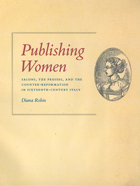 Publishing Women: Salons, the Presses, and the Counter-Reformation in Sixteenth-Century Italy
Diana Robin
University of Chicago Press, 2007 Even the most comprehensive Renaissance histories have neglected the vibrant groups of women writers that emerged in cities across Italy during the mid-1500s—and the thriving network of printers, publishers, and agents that specialized in producing and selling their books. In Publishing Women, Diana Robin finally brings to life this story of women’s cultural and intellectual leadership in early modern Italy, illuminating the factors behind—and the significance of—their sudden dominance.
Focusing on the collective publication process, Robin portrays communities in Naples, Venice, Rome, Siena, and Florence, where women engaged in activities that ranged from establishing literary salons to promoting religious reform. Her innovative cultural history considers the significant roles these women played in tandem with men, rather than separated from them. In doing so, it collapses the borders between women’s history, Renaissance and Reformation studies, and book history to evoke a historical moment that catapulted women’s writings and women-sponsored books into the public sphere for the first time anywhere in Europe.
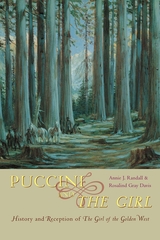 Puccini and The Girl: History and Reception of The Girl of the Golden West
Annie J. Randall and Rosalind Gray Davis
University of Chicago Press, 2004 Set in the American West during the California Gold Rush, La fanciulla del West marked a significant departure from Giacomo Puccini's previous and best- known works. Puccini and the Girl is the first book to explore this important but often misunderstood opera that became the earliest work by a major European composer to receive an American premiere when it opened at New York's Metropolitan Opera House in 1910. Adapted from American playwright David Belasco's Broadway production, The Girl of the Golden West, Fanciulla was Puccini's most consciously modern work, and its Met debut received mixed reviews. Annie J. Randall and Rosalind Gray Davis base their account of its creation on previously unknown letters from Puccini to his main librettist, Carlo Zangarini. They mine musical materials, newspaper accounts, and rare photographs and illustrations to tell the full story of this controversial opera. Puccini and the Girl considers the production and reception of Puccini's "cowboy" opera in the light of contemporary criticism, providing both fascinating insight into its history and a look to the future as its centenary approaches. “Engrossing. . . . An eminently readable, ideally direct and information-packed book.”—William Fregosi, Opera Today
Puccini: His International Art
Michele Girardi
University of Chicago Press, 2000 Puccini's operas are among the most popular and widely performed in the world, yet few books have examined his body of work from an analytical perspective. This volume remedies that lack in lively prose accessible to scholars and opera enthusiasts alike.
|
|
